 home coil info products ordering
home coil info products ordering
Gardening with Orgone
Mid-April, 2005: We are having an unusually early growing season this year. At least the plants seem to be expecting it. Not only do I have the usual April dogwood flowers, but it isn't even mid-April, and the wild cherries have already flowered, and some of them have already dropped their flowers! My dwarf cherries have already dropped their flowers. My Asian pears have beeen flowering for some time.
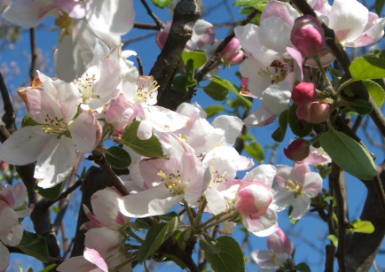 Even my apple is already in flower! Here is a pic, taken 4/15. The red balls are unopened flowers.
Even my apple is already in flower! Here is a pic, taken 4/15. The red balls are unopened flowers.
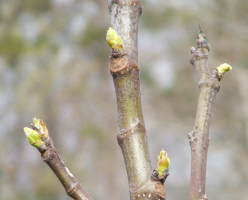 And my Brown Turkey fig is already about to leaf out. This is way early. Pic taken 4/12/5.
And my Brown Turkey fig is already about to leaf out. This is way early. Pic taken 4/12/5.
Incidentally, this fig suffered scant damage last winter, despite some single-digit weather, and no protection except for a heap of mulch over the roots. I suspect because it is closer to heavy orgone than my Celeste fig, which seems to have most of the above-ground portions frozen back, which is usual for my figs. I will need to place some more goodies near the Celeste.
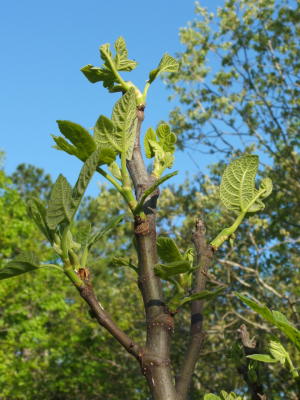 This pic taken 4/22/5. Note that the tips did not freeze back on the Brown Turkey fig. Some small, lower branches did. It is normal for most of the above-ground wood to die back (I planted only varieties that will fruit on new growth from the root). I have never had the tallest branches fail to freeze back at least halfway down from the top. As I said, I gave them no protection from the winter wind. I recorded 2 degrees F on 12/23/4 and 12/24/4, 3 degrees on 12/25/4, and 6 degrees on 1/23/5. It was a cold enough winter to kill most of my shrubby St. Johnswort perennials (which happens every few years).
This pic taken 4/22/5. Note that the tips did not freeze back on the Brown Turkey fig. Some small, lower branches did. It is normal for most of the above-ground wood to die back (I planted only varieties that will fruit on new growth from the root). I have never had the tallest branches fail to freeze back at least halfway down from the top. As I said, I gave them no protection from the winter wind. I recorded 2 degrees F on 12/23/4 and 12/24/4, 3 degrees on 12/25/4, and 6 degrees on 1/23/5. It was a cold enough winter to kill most of my shrubby St. Johnswort perennials (which happens every few years).
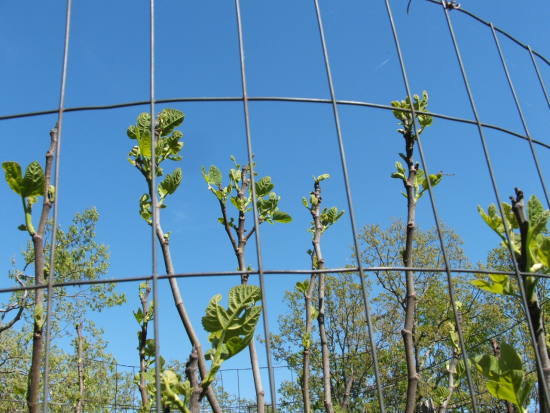
The above pic was taken 4/24/5. All of the tall stalks survived with only negligible damage at the tips.
On 4/26/5, I noticed that the tree had already set several fruit about 1/2" in diameter!
This tree is fairly young. Last year was the first year it produced good fruit, maybe 30 or so delicious figs. I ate the first 2 of those on 8/14/4.
Here's a gratuitous pic of sweet rocket, taken 5/1/5. I like sweet rocket: the deer and bunnies don't touch it, despite the fact that it makes OK salad in March before anything else is edible, along with chickweed. Bugs don't bother it. It spreads like a weed, but is extremely easy to pull up where it gets in the way. I don't know of another plant that has such quick-release roots coupled with such a thick, traction-grip handle. It is colonizing areas of my property.
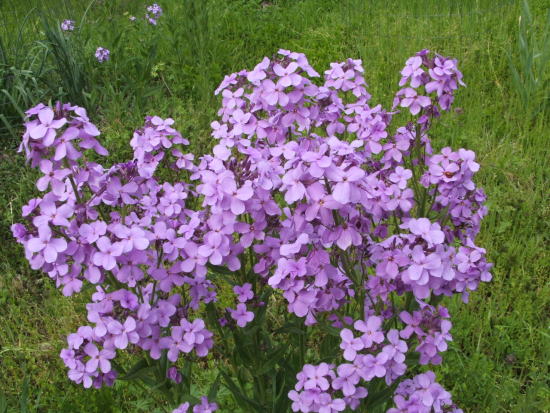
The color is a rich purple, much nicer than in the pic. In rich soil, it grows tall and very thick. In poor soil, it sends up a skinny, short version (see background).
 Here's my other fig, already sprouting leaves.
Here's my other fig, already sprouting leaves.
Taken 5/3/5.
Only one shoot appears alive so far, and only partway up.
I accidentally left the cage door open after I photographed it, and a day or two later discovered that, apparently, a fawn or something had gone in there through the dead stalks and nibbled off those few leaves. Must be something about young fig leaves. They never touched the ones that poke out the cage in the summer.
Notes of June 16, 2005: Agnihotra and agnihotra ash. I have been doing agnihotra in the garden a fair bit, as well as using the ashes. I was curious about the panacea-like effects I had read about.
I have on 2-3 occasions watered a Russian Hawthorn with ashes in the water, maybe a couple tablespoons each time. This plant had been very eaten up by mildew the previous year. This year it is doing a lot better so far, but it has also been a lot drier this spring. And there still are mildew problems. This plant is some distance from where I did the fires, though. I suspect the ashes are helping significantly, but not as miraculously as I'd hoped.
Interestingly, I have seen no trace of the usual Colorado potato beetles or their larvae on my potato plants yet. I have watered them many times with ash water, as well as sprinkled ashes on the leaves a few times.
The other plants in or near the garden where I did the fires are also doing very well. Except my tobacco starts are getting munched before they get 1/2" high. And a couple tomato starts I bought early have always been grossly stunted despite everything. There was something wrong with them. The other tomatoes have been doing fine.
Jan. 12, '07: Whew, I had a bunch of weird crap, droughts, demons, etc., I had to deal with, but now that that's pretty much done, I can get back to what's truly important: gardening.
Update: That Brown Turkey fig also leafed out real early in '06, after surviving some more single-digit weather without protection, whereas the Celeste again froze down. Is it genetics (there are lots of variations within each cultivar type of fig) or orgone? I don't know. On the one hand, the Celeste doesn't seem to have gained any advantage. But, I also noticed that my pawpaws, all of which regularly, every winter, froze to the ground pre-orgone, never do anymore, even tiny ones.
I noted no potato beetles the last 2 years, and would have to credit the agnihotra ash for that much. The Russian Hawthorn was healthier last year. The stunted tomatoes never grew much; I suspect they were genetic mutants.
Pine tree orgone: It appears that conifers, especially pines, are generally more orgonaceous than deciduous trees. One interesting species is Pinus sibirica, called Siberian Cedar although it is a pine. Several months ago, I received an unsolicited mailing from Toronto. In it were 3 brochures from a group I had never heard of. (www.ringingcedarsofrussia.org) Also a disk of wood, about 1.5" diameter and 1/4" thick, with a hole drilled in it for a string. This slice of pine had the most wonderful energy to it, so I carried it on me a lot.
Later, Kneweyes got into this stuff independently and sent me some info from their site. One is supposed to wear the slice as a pendant, and rub it occasionally with the left hand for good health, longevity, etc. I'm a believer. When rubbing it with the left hand, one gets remarkable good energy. I wear it most of the time.
There is even a reputable vendor that sells the saplings for planting in the US (info) but I am just south of the climactic range, and probably would do just as well with my native yellow pines.
These latter seem to have more positive energy that the other trees I have. The energy is mainly driven downward into the Earth.
Sometimes I have to remove a pine tree to allow more sun on other plants, so I lean my 17' ladder up against the tall trunk and climb up there and cut it most of the way through, leaving enough for me to get back down safely. It falls within a few days, leaving a 20' standing snag for wildlife habitat. This continues to send significant orgone downward for years, though it fades.
A few months ago I had to cut 4 big pines down to the ground. I wanted to use them for making raised beds in my new garden space, but most of the logs were so heavy that I recently cut them into 17" sections (17" is a good orgone length, as are other lengths mentioned on my coil info page) and stood them upright in a circle, which I filled with compost, etc.
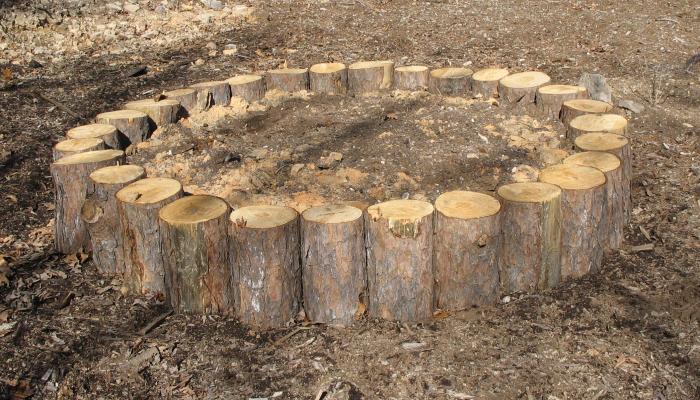
I put all the sections base downward, that is, with the same orientation they had when alive. This sends loads of orgone downward.
They should last several years, after which I can compost what's left of them.
April 9, '07: Nature did not predict the unusual hard freeze on Easter after an unusually warm March. I had 24 F yesterday morning and the morning before. Many things had leafed out and/or flowered early. Even my native hickories and wild persimmons got their leaves all wilted, dark, and drooping. So did the early potatoes that had sprung up from last year's leftovers, my hydrangeas, pawpaws (which were in flower), buartnuts, and my 3 Chinese treelings: che, Li jujube, and wild black persimmon..
My mints and some grapes got half-frozen off.
Amazingly, my Brown Turkey fig, which leafed out some early as is its wont, does not appear too badly burnt, hopefully. My Celeste fig had not yet poked out. And some daikon I'd planted a few days ago is pushing up out of the soil! Yum.
Lately I have cast and distributed a number of little orgone devices for my plants. While the epoxy was curing, I used my SE-5 radionics device to imbue them with N or NPK, as well as other energies and nutrients. I even put small amounts of a better high-phosphorus synthetic fertilizer in many of them: 10-60-10 with a few minerals. I almost never use synthetic fertilizer.
These things have wonderful energy, and I'm hoping to possibly relieve myself from the necessity of having to supply physical nitrogen to the plants.
Also I always add a tiny pinch of agnihotra ash to the water when planting stuff.
May 15, '07: Actually, the Brown Turkey fig did get nailed good. And so did a few other cultivated and native plants. Though a few are producing a few fruit despite that.
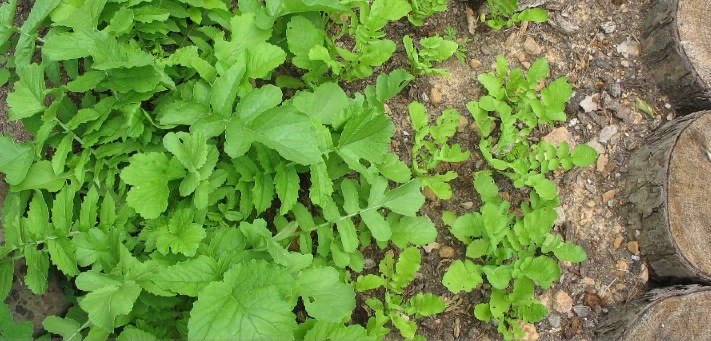
Dig this: note how the daikon closest to the edge of the garden bed are small, whilst those near the center are large? The difference was even more striking with the beets. The peripheral ones were so tiny you could hardly see them in the pic I took, which is why I'm not publishing it. Carrots were similar.
Why is this? Are the pine logs exuding something toxic? Or is it that much more dried up toward the edge?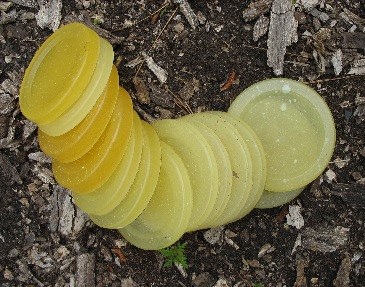 Or, or... could it be that in the center I had a couple epoxy devices, one old one with a water bottle in it, that I retroactively programmed with nitrogen, etc. freqs, and a newer disk like I mentioned above? Well, I suspect the latter, so I made up some more of those disks, and put 4 more around the edges of the bed, at the cardinal directions (I'm into cardinal directions).
Or, or... could it be that in the center I had a couple epoxy devices, one old one with a water bottle in it, that I retroactively programmed with nitrogen, etc. freqs, and a newer disk like I mentioned above? Well, I suspect the latter, so I made up some more of those disks, and put 4 more around the edges of the bed, at the cardinal directions (I'm into cardinal directions).
[No, duh, it was compostables I had buried in middle months before.]
These disks contain only some old fast-curing epoxy I had around that is not much good for sophisticated devices, and a little bit of 10-60-10 with its bit of iron, manganese, and zinc.
And programming.
June 5, '07: Here's a special "orgone carrot" I picked today.
Here's a special "orgone carrot" I picked today.
I have satisfied myself that it is true what they say about the futility of starting cantaloupes early indoors. All the ones I planted like that were stunted compared to the ones I planted from seed later. With the lemon cukes, there is no discernable difference between the ones planted early and transplanted, and the ones I planted directly from seed.
All my "bolt-resistant" daikon bolted early, and are now pulled up. I did get to eat a few that were 3/4" diameter, and one that was 1".
Everything I have been eating out of my round garden bed is super-yummy. All picked on the small side because, well, I'm hungry. Just daikon, carrots and beets so far, but I have zuke plants coming along.
June 18, '07: I am embarrassed. A couple days ago I suddenly remembered what is no doubt the main reason for the uneven growth noted May 15: I had not loaded the bed up uniformly at all.
When I filled it last winter, I avoided putting any of the richer, livestock manure compost near the edges of the bed. Plus, a few times I dug holes near the center and buried coffee grounds, flour sweepings, etc. from the bakery.
I have read that it can be done, gardening with little nitrogen input, but so far in my experience the lushness of growth is fairly proportional to the amount of coffee grounds I manage to scrounge up (can't drink the stuff).
I'm confident that the orgone disks do help the plants at least a little, but obviously they are no substitute for physical nitrogen. Though the comfrey I planted last fall from chunks of root has been doing real well so far with very little physical nitrogen. Growing in mostly clay. I found out the hard way that that is what comfrey likes, after killing several plants by planting them in fluffy compost.
Comfrey, of course, is a well-renowned fertilizer, so if one were able to grow quantities of it with little nitrogen inputs, one could still come out ahead.
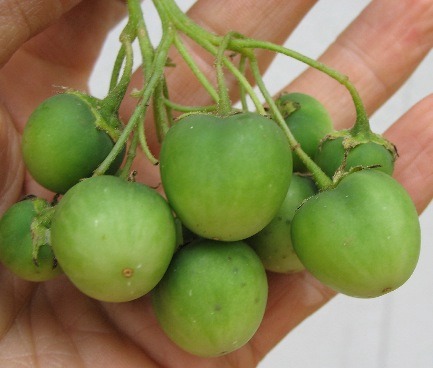 Here's an oddity. I grew a different variety of russets this year, and a few of the plants formed berries. I did a web search, and found they are very poisonous.
Here's an oddity. I grew a different variety of russets this year, and a few of the plants formed berries. I did a web search, and found they are very poisonous.
I sprinkled very small amounts of agnihotra ash on the plants every few days, and once again had no potato beetles at all. Also, I have not yet seen any blister beetles this year (but it's still early).
July 13, '07: Still no blister beetles.
I noticed a couple weeks ago that the comfrey had stopped growing, and the leaves were discoloring and looking sad. Despite relatively cool, mostly overcast, damp weather. So I fed the plants a bunch of nitrogen in the form of diluted urine, and sure enough, they picked right up and put out a bunch more lush growth. So obviously, I'm far from weaning my garden from nitrogen inputs.
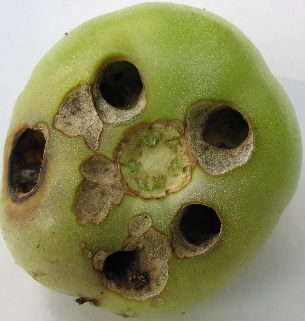 Aug. 3, '07: On July 18 I found this tomato on one of my 2 Arkansas Traveler plants. I don't know what caused this. [Update: it is a very dark caterpillar that looks like a slug at a distance, I noticed years later.] But so far, no other blemishes or flaws of any magnitude on the fruit. No bugs in evidence, except for a few tiny holes in some of the leaves. I've been sprinkling a little agnihotra ash on them every few days. Ordinarily, I would have expected blister beetles and hornworms by now. Not to mention blossom-end-rot, which I have aways gotten some of before. I did find a few blister beetles on 7/20 on some beets in the lower garden that I had not ashed. Also on that day I picked my first 2 ripe tomatoes -- very late due to all the cool weather.
Aug. 3, '07: On July 18 I found this tomato on one of my 2 Arkansas Traveler plants. I don't know what caused this. [Update: it is a very dark caterpillar that looks like a slug at a distance, I noticed years later.] But so far, no other blemishes or flaws of any magnitude on the fruit. No bugs in evidence, except for a few tiny holes in some of the leaves. I've been sprinkling a little agnihotra ash on them every few days. Ordinarily, I would have expected blister beetles and hornworms by now. Not to mention blossom-end-rot, which I have aways gotten some of before. I did find a few blister beetles on 7/20 on some beets in the lower garden that I had not ashed. Also on that day I picked my first 2 ripe tomatoes -- very late due to all the cool weather.
The tomatoes and my cantaloupes are in my upper garden, which is much hotter on a hot summer day than down below.
Although the 'maters were late, the cantaloupes were a bit early. I have been growing these Jenny Lind cantaloupes for years here, but the earliest I ever got ripe fruit was Aug 6. Sometimes it takes until fairly late August. Yesterday I picked up a couple that fell off the vine due to ripeness, and ate one today. I guess all the rain, plus the heavy layer of composted bark mulch I put on that garden last year, helped. Also, the melons are growing on a dog-wire trellis that is connected by a wire to the mobius circuit in the big upside-down chembuster buried under the trellis. Just a single wire spur wrapped around the trellis suffices to make the trellis radiate good orgone. Plus I've been sprinkling a bit of the ash on them, too. This is the most impressive crop of melons I've grown yet. Despite the wet weather, their leaves hardly got any mildew.
Unlike my cukes and zuchini in the lower, cooler, shadier garden. Though these are still producing.
Aug. 14, '07: There's been a dry heat wave here the last couple weeks or so. The melons and 'maters are growing in a spot that gets very hot on a hot day. I've had a great crop of melons, despite the fact that many are getting scalded/softened by the heat before they ripen. I've thrown many away. I have not been watering the melon vines, which are pretty shriveled up now. Grasshoppers love heat, so congregate in this garden now, and munch holes in the occasional melon.
So far I have found 2 tomatoes with blossom-end rot, and a few with minor insect holes. One with a bird hole. But most are still cosmetically perfect, or nearly so, amazingly. I water them daily. Still no hornworms or blister beetles. I don't think the grasshoppers are eating them much, either. It's the ash.
The zucchini still has not suffered much from bugs. I haven't ashed it in a while, and the grasshoppers got after it some. The older leaves are covered with white mildew, and the new ones are green.
I tried growing ashwagandha this year, and found it hardly grows at all unless it's really hot and well-watered. Then it grows quickly.
Aug. 20, '07: These last few days I have been getting a bunch of blossom-end rotted tomatoes. This is an ailment normally considered to be associated with mineral deficiencies.
The heat has abated some. I still have a few green cantaloupe vines, and a few melons.
Despite ashing, I have some unrecognizable tiny black bugs (not aphids) on my zucchini. But I'm not sure they are eating the leaves; they might be preying on smaller pests, like aphids, that I haven't spotted. Also the zukes have ants, but again, if they are farming aphids, I haven't seen those.
Aug. 22, '07: Despite a faint ash sprinkle 2 days ago, I have stinkbugs and grasshoppers nibbling on the tomatoes. I also picked off the 1st hornworm of the year, and several more blossom-end rotted fruit. Some good-looking green fruit coming along, but with the intense pressure (droughty and nothing else juicy to eat) it is difficult to deter the bugs.
Sep. 3, '07: A couple days ago I sprayed the tomato plants with bio-insecticide. They were covered with stinkbugs, hornworms, and grasshoppers, their fruit largely munched. I haven't checked back yet. Weather is still dry and pretty hot.
Never did see any blister beetles this year, except for those few once in the lower garden.
Today I ripped out the 3 zucchini plants from the round bed in the lower garden. They had a few tiny fruit on them, but these were not growing much. I presume the vitality of the plants was flagging due to age, although they were still producing some new leaves and flower stalks. Possibly with a shot of something high in nitrogen and some extra water they might have picked up again. But I wanted to prep the bed for root veggies which I will plant in a few days.
It is noteworthy that the zukes never got squash vine borers at all. This is the first time I have planted zukes here, having been so intimidated by how notoriously voracious these bugs are around here. Of course, the first year will always be lighter on this kind of bug. I'll try again next year. I suspect that the holy ash and maybe the orgone helped a lot to repel these bugs.
Sep. 6, '07: The late-summer drought has broken. Almost 4.5" in the last 2 days.
Today I planted daikon, beets, and carrots in the lower round bed, and more beets and acorn squash in the top garden. Found 3 tomatoes that would have been perfect except they'd split their skins from the sudden rain. Only a few stink-bugs on those plants today. I sprayed some pyrethrum stuff on them, gave them a good shot of N (urine) and some more water. Probably will get more good fruit; weather's still warm.
One of the ashwagandha plants up there had fruited. I tasted the fruit for the first time.
Sep. 18, '07: The daikon I planted 12 days ago is about 6" tall, and the beets much smaller. No carrots noticed yet. Grasshoppers or something were mangling the daikon, so I sprinkled holy ash on them, which seems to work.
I am impressed by the ash. I did have a record infestation of stink-bugs on my tomato plants late this summer, though. Maybe the ash doesn't do much to them.
Acorn squash is up, but I suspect it's too late in the year to produce fruit -- we'll see.
Got some clean-looking tomatoes on the vine again, but I'm uncertain whether they will get good color or flavor this late. Yet, we have daily 80s and even 90 degrees in the week's forecast, so maybe.
Sep. 21, '07: I neglected to ash the acorn squash, so they got munched. Tomato plants look healthy again, with a number of green fruit. I picked off and killed 3 stinkbugs, is all. Sprinkled some ash on the plants. Daikon are coming along. I sure hope they don't bolt; it's been in the upper 80s a lot lately.
My juneberry by my cabin had a few late flowers lately, but I don't think any fruit set. And now my best-fed dwarf Korean cherry is flowering so late! Maybe I'll get fruit this year after all.
When I approached the garden, I sensed a good entity, that "evaporated" as I approached. I think it was a nature spirit of some sort. I haven't had an awareness of them before.
Oct. 2, '07: Radionics v Moles? on 9/29 I noticed that moles had gotten into my round raised bed with the young daikon plants, etc. and had churned up much of the top surface, stressing some plants so that they wilted. This is despite the fact that I had a steel mole-chasing whirligig (usually fairly effective) 20' away.
That night I had my SE-5 with some orgone stuff and a lotus coil on it, set to REPEL MOLES from that space, and program the orgone devices in the bed with the anti-mole freq. Next day, no evidence of additional mole activity. I ran it again that night for good measure. No more moles since.
This morning I moved the whirligig to one of the steel posts holding up the fence around the bed.
Still got healthy tomato plants with fruit that is still green, despite daily weather in the 80s.
Cuke plants still alive, but not producing. A cantaloupe plant is flowering.
Most of my comfrey plants got fried to death, apparently, last heat wave (during which I did not water them). At least, they haven't re-sprouted yet.
Nov. 23, '07: Still no more moles down there. Don't know how much of that is due to my moving the whirligig closer.
The first day of Fall was on Nov. 1 at my place. Colors were pretty nice for a couple weeks, then faded. Yesterday morning was the first it got below freezing this fall: 31 degrees. And 21 this morning.
Green figs that never ripened, ditto those late tomatoes (with few exceptions). The late cherries got munched by something. No wild persimmons this year.
Been eating nice daikon with a diameter of 1 to 1.25".
Dec. 4, '07: Growing nice daikon has been a challenge to me. They bolt in the spring here no matter what, and in the past I have not had luck with a fall crop, either. But this season I planted them as soon as the heat/drought of the summer broke in early September. We haven't had any severe frosts yet. I cover them with blankets when it gets down to 30 or so. The weather has been mild enough that they are still growing.
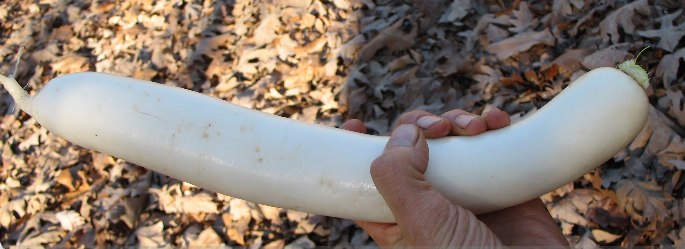
I got some lunkers coming along now. This one is 2" in diameter, the first serious-sized daikon I have ever harvested.
Yum. I just ate the first half, will eat the rest tomorrow. Flavor is superb cooked, but too hot to eat raw. Almost no woodiness has been noted in the roots so far.
And still no more moles in that bed. I did have to sprinkle ash on the plants until a few weeks ago, to slow down the grasshoppers.
Oct. 30, '08: It was a good year for gardening. I hardly even used any agnihotra ash, yet saw only 1 blister beetle all year, as I was tearing out my spent cantaloupe vines. No potato bugs, even in areas where I had never grown stuff before or sprinkled ash ever. But things aren't in ideal balance, as today I had to sprinkle diatomaceous earth on a bunch of plants that were infested with those green-with-black-spots beetles as well as grasshoppers. The latter were a bit worse than usual this year.
I did have hornworms earlier, too.
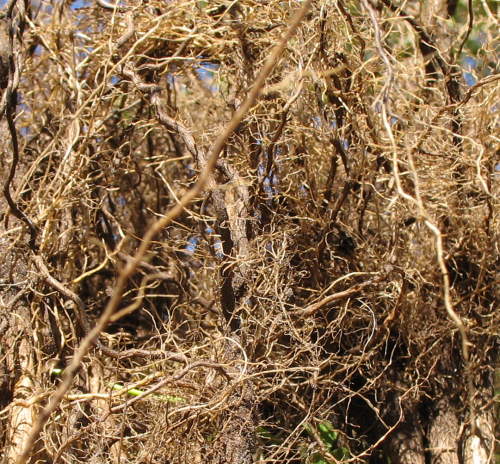 I grew a couple plants this year that are useful for orgone devices. One is holy basil AKA tulsi AKA tulasi. All parts of the plant have good energy. In the past I have used commercial Indian tulsi, a very fine powder, in orgonite mixes, sometimes quite liberally. Also I have some Indian carved beads made from tulsi stem.
I grew a couple plants this year that are useful for orgone devices. One is holy basil AKA tulsi AKA tulasi. All parts of the plant have good energy. In the past I have used commercial Indian tulsi, a very fine powder, in orgonite mixes, sometimes quite liberally. Also I have some Indian carved beads made from tulsi stem.
Tulsi is reputed to be a very healthful herb for teas: adaptogenic, anti-oxidant, etc. I like to munch a leaf or two in the garden.
It has a strong taste, and bugs and diseases seem to avoid it. The cluster of plants seemed to radiate good energy.
I harvested some for the herb, and also ripped out several entire plants for the stems and roots.
Then today I noticed that the remaining plants, which I was hoping would produce seed, but never did, had turned brown and wilted after the recent frost. So I ripped out the rest of the plants, which had been in flower for a very long time, and snipped off their roots. The roots (depicted) have the strongest energy. The root hairs are strong, too.
I had the intuition to merely shake off as much dirt as I could, and let the roots set in the sun for a few hours before bringing them in to finish drying. I had the feeling that the sun would improve the energy.
The other plant is nicotiana rustica, an ancient Indian tobacco that is like 20X as nicotine-rich as cigarettes. Surprisingly, the bugs love it. In fact tiny hidden hornworms ate a bunch of my harvest while it was drying! Of course they grew quite long and fat in the process. Even in tobacco that was mostly dried up, the hornworms seemed to thrive.
I sometimes use both of these plants in devices. Usually a very small amount is all.
Jan. 1, '09: 2008 was the year for entities in the garden. I had greys and reptilians hanging out in my plants and stored water supplies. I'd remove them and more would come. Meanwhile, good entities were starting to inhabit the garden, and the bad ETs would harrass them.
I eventually programmed a big rock to sweep for and arrest these ETs, but I would have to mentally nudge it occasionally for it to work well. Then 4 military male type elves of the Um (oom) species installed themselves and were excellent at keeping my property clean of bad ETs. Except their effectiveness diminished the deeper underground that the bad guys installed their nests, so I still have had to occasionally sweep way down there. One of the bad ETs' favorite places to nest was deep under the location where the Um guys hang out, at numerous different depths simultaneously.
But now I am having scant problems like that anymore.
Right now on my property I have:10,000 pixies2 million sprites (many of these are inhabiting my orgone devices)20,000 devas4 warrior elves1 kami (powerful nature spirit that helps a lot with weather matters)
Now if I even take a cutting and stick it in a pot, immediately a sprite will inhabit it. The sprites seem like tiny points of flashing light, and they like to hang out in orgone devices containing blinking LEDs and crystals.
The pixies are ~6" tall humanoids. I'm not getting an impression of the color. Often one will adopt a plant for the season, and hang out with it.
The devas I don't know much about. Many of them hang out in the rocks on the ground, others in the plants.
Pixies and devas hang out in my orgone devices, too.
The elves are ~4' tall, white humanoids.
The kami has so far shown herself to me in 2 shapes. Mostly she has manifested as a 5D, 9' tall, hairless, light blue, broad, voluptuous, attractive woman. But sometimes she's a gorgeous, slender, 6' tall 7D girl with golden-brown skin, curly red hair, and brown eyes.
I emailed a friend asking what his impression was of the appearance of kamis, and he said 25' tall, very hairy, gorilla-type things! Well, I haven't been shown that yet, but I get that that is her 11D appearance. Why they would have such a seemingly coarse, brutish appearance on a higher dimension, I do not know.
Jan. 17, '10: 2009 was a good year for gardening. I still have the same number of allies in the garden, but the number of elves has increased to 10.
Here are a few pics of specimen root veggies I grew: beet, parsnip, parsley root, carrot. With the exception of the beet, these veggies have been grown in a raised bed that had mostly clay loam in it, as I had run out of compost. Therefore, many of the roots were stunted, split, warped, etc. These were the best specimens.
2010 should be better for this bed, as the bark mulch and earthworms I added have softened the soil some, plus I plan to work in some goat poo.
I put together some large, deep raised beds. I have become a great believer in the magic of raised beds and planters. A large part of the reason is explained here. If planterizing rocks for a year in a deep planter imbues them with remarkable programming, what does the energy responsible for that do for your soil and veggies?
I have already started prepping more old tires to use as planters in 2010. These are a great choice because
[Update 2020: I have dismantled my tire beds. Tires contain heavy metals and they do break down and turn to black powder that smudges your skin.]You can get them for free at places that replace tractor tires, etc. They may even load the bigger ones into your pickup for free with a forklift.They resist the sun's rays for a long time (I have heard of people painting them, even).Their roundness means that the strong summer sun will not hit a flat surface that absorbs the heat more.
Some tips on this:You should try to get fat tires to take advantage of the magic that happens when you have 1 foot of soil in them. However, for growing things like mint, I use thinner ones. Incidentally, another advantage of planters is that you can keep aggressive plants like mint sequestered from the rest of the garden.
Also one can stack tires on top of each other for more height.You need to remove the sidewall from the top side, and maybe the bottom, too.
At first I labored hard with a utility knife. This can be done, but you have to score the cut many times before you break through. Hard work.
Then someone told me to use a saber saw with a metal-cutting blade. I fired up my generator and ran my saber saw. It was hardly less work than the utility knife. A lot more vibration than cutting.
Then I figured out, instead of using a short-bladed knife, I should use a sharp knife with a long, thin blade. Maybe a steak knife or fisherman's knife. Use a spade bit to drill the initial hole. Due to the long blade, you can saw through the sidewall much more easily than scoring shallowly with a drywall knife.
Then it occurred to me that my short-bar chainsaw would probably work great, especially on real big tires. I haven't tried it yet, but will soon.
We had a lot of wet and cool weather in 2009, so most of my tomatoes did not do well.
Because I had so much new raised bed space, I experimentally planted some species I normally wouldn't mess with. The only ones that did well were my favorite standby Arkansas Traveler which I grew from seed, and a Grape Roma hybrid plant I bought. I didn't get any good-tasting fruit from my Husky Cherry Red, although I have grown this variety in other years when it was excellent. I did not get a single decent tomato from my Cherokee Purple. They all cracked long before ripe. I got 1 decent tomato from my Brandywine, off a remarkably large, lush plant with plenty of big fruit, which mostly split/rotted before ripening. I don't think I will grow either of these 2 again, as in a best-case scenario they can only hope to occasionally equal the quality of Arkie Travs.
All these tomatoes were grown in deep planters filled with fluffy compost, which had excellent drainage, as well as regular watering when the weather was dry. Nonetheless...
Bugs: I did not use agnihotra ash at all, hardly. I only did 1 homa fire in the garden.
I had no potato bugs, but then I didn't plant potatoes either. A few came up volunteer.
I had some little caterpillars on the radish leaves, which I fought by sprinkling diatomaceous earth on the leaves. And manual squishing.
I had blister beetles and some stinkbugs, mostly on the tomatoes. Only a few at a time. I sprayed these almost daily at times with a solution of natural soap. I used a stronger solution than one would use for misting aphids or the like, but shot it in a straight stream right at the individual bugs, which is deadly to them without drenching the plant with soap too much. The wire cages made it inconvenient to manually pluck the blister beetles.
I had a few tomato hornworms, which I picked off and squashed.
I had a few more holes bored into tomatoes like in the green tomato pic above.
A late freeze nipped my fruit trees, so I got no fruit off them except wild persimmons. Also my Charlie's Golden autumn olive fruited for the first time. And I got plenty of green figs that never ripened, as well as a few dozen good ones . Wild muscadines did well.
April 24, 2015: OK, time for an update; it's been over 5 years since I last wrote anything on this page. Then later I'll have some interesting new subjects to write about.
The Russian hawthorne has been dead for many years. As has my Celeste fig. And the Chinese wild black persimmon. And the Charlie's Golden autumn olive.
My old Brown Turkey fig is not doing real well, as I have ignored it for years since I started a new one at a lower altitude, which is doing well. Or was until the brutal winter of 2014 which froze it to the ground. Then it came up from the roots that year, but never fruited, and the winter of 2015 froze back the new growth. The roots have not yet re-sprouted but then it is still cool weather at night.
I haven't done agnihotra or homa in years, and only on rare occasion sprinkle a bit of the ash on plants. However, I credit the ash for having rid my property of certain insect pests that had shown up the first year I gardened here. Specifically, it seems to have permanently rid the place of potato bugs. And virtually rid it of blister beetles. I used to have to harvest dozens of blister beetles off my tomatoes daily, but now I have seen virtually none in years, and never near my garden. That is a big deal.
However I have not found homa ash very effective against hornworms, stink bugs, squash bugs, or aphids.
My pawpaws all died, the bigger ones due to failure to irrigate in the hot summer, and some tiny ones in pots got cut off near the soil by bugs. I do have one small one slowly growing in a good place, though.
My pine-log raised bed was torn down rotten last December.
I doubt that the epoxy disks I made in May '07 are of much value, but since I have gifted my gardens with various new programs (which also are not objectively tested).
Apparently what I've had is voles, not moles. But the whirligigs usually repel them, except when some populations adapt to the noise.
Maybe next update I will explain how I defeated squash bugs, and give some tips on growing turmeric roots.
April 28, '15: A couple days after I posted last, I noticed that my fig was sprouting a little already.
OK, here's my secret to growing squash despite squash bugs. Well, at least it has withstood the test for the past 2 summers.
Years ago I grew squash for 3 years straight without seeing a squash bug. Then the next summer, I had them, and the following year they were terrible, and also had lots of stinkbugs hanging out with them. They ruined my crop.
Then I didn't even try to grow squash for a year or two.
But someone told me that the thing to do is to keep row cover on the plants until they flower. Then remove the cover so that the pollinators can do their thing.
The result being that this delays the advent of the squash bugs. So by the time they've done a lot of damage, their eggs have hatched out, etc., you'll already have gotten a fair bit of fruit.
However, it turned out much better for me, because I delayed planting as well. Apparently if the squash bugs don't find anything edible when they hatch out, they eventually starve or move on. So I waited until the soil was pretty warm to plant, and thus by the time the plants flowered, and I removed the row cover, apparently the bugs were gone. And also I did not have stink bugs on them.
Thus I had healthy plants and plenty of mostly perfect fruit. I even started a larger 2nd crop mid-summer (not needing to bother with row cover then as obviously there were no bad bugs out), and got loads of fruit off that, too. I sliced up and dried a whole bunch for eating through the winter.
I love summer squash.
May 1, '15: BTW, I don't actually eat sweet rocket. It is supposedly edible, but the fact that neither the deer nor rabbits will touch it, makes me wonder.
It is in full flower now. I have spread it over much of my place.
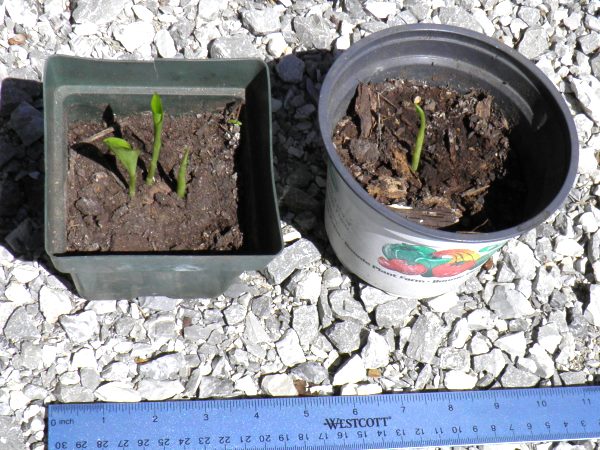 Turmeric: Last Sep. 15 I blogged:
Turmeric: Last Sep. 15 I blogged:You can get fresh roots on eBay early in the year and plant them. However, based on years of experience i have found that it takes at least 5 weeks under ideal conditions for the shoots to pop up, then they grow very slowly for a month or 2 before getting of any size. Right now i have a few plants around a foot tall, and the rest are smaller, some still tiny even this late in the year. But summer arrived late this year.
Next year i will see how early i can buy them and pot them them indoors until it is reliably warm out.
In fact i did that with a few tubers this year; stuck them in pots with a shallow layer of dirt, and later planted them in the ground. Even some of those are still small. In fact one is still in a larger pot, which i will take indoors this winter to see if i can get an early start next year. In fact i may pot up some of my smallest plants and do the same.
An expert herbalist once told me that the little penis-like offshoots from the main tubers are the richest in compounds which relieve muscle pain. So if i get a big tuber in the mail, i will break off the little arms and plant the main body.
The ones i potted up early this year were sent to me by my mom who bought them from Whole Foods, allegedly organic. And many of the offshoots were missing, suggesting that perhaps someone had broken off and bought the offsets at the store.
If you refrigerate the fresh roots for more than a few days they will spoil. They are best stored (after being washed and dried
if you plan to eat them) in a paper bag in a dark, cool, dry place. However they will then dessicate slowly over the months. (If there is any moisture they will mold.) They can be pickled or preserved in alcohol like diluted vodka.
That was last year's crop. It was puny. My yield was about the same as my input of roots. Some of the plants did not even produce anything.
At the end of the season, I potted up 2 of the smallest, and kept them indoors over the winter. I now have a sunny grow room in an outbuilding, so I was able to keep them from freezing. These 2 have not resprouted yet.
Also when I came back from Virginia late last January, I brought some more of the tubers from Whole Foods. Some I ate but I also potted up 8 larger pieces.
These as well as the 2 from last year I kept slightly moist, but not soggy. As the weather got warmer I kept the room warmer and also ran fluorescent lights. Finally in mid-April one of the roots I had brought back sprouted! That's the one on the left. The other one sprouted a week or so later. Today I planted both of these outdoors with a dollop of bone meal, in an old tire with the sidewalls cut out.
So far none of the others have sprouted, but it looks like I am getting an early start. For comparison, in 2011 (the only year I kept notes on growing turmeric) I recorded them sprouting on July 26.
However, I also got a somewhat early start on a few specimens last year, and it didn't do me much good. We'll see how it turns out this year.
I did grow a big crop here the first year I tried. They didn't really grow much until around September, as I recall, yet I ended up with a large amount, and gave a lot away. I do not know why all subsequent attempts did poorly. Maybe the fact that I have had no animal manure to add since then is a factor.
July 7, 2015: Here it is about 10 weeks later and what progress has happened with the turmeric? We have had warm weather but not scorching.
The 2 depicted above are now 15 and 17 inches tall. And only 2 more have sprouted. One was the largest, a plant I had dug up and potted last fall. It sprouted May 11, and is now in the ground and 28" tall. The other one only sprouted recently, and is 3" tall.
That leaves me with 6 which haven't even sprouted. They may have rotted because I potted them too early from bought tubers in winter; I have not poked around in the pots to see.
And I have several yellow squash plants growing under row cover.
July 13, '15: I waited until this morning before pulling the row cover off my squash plants, despite the fact that I had been noticing flowers on them. I was surprised to find that several fruit were already forming, despite blocked access to pollinators. Each plant was sequestered from the next, so these plants must be self-pollinating, unless some little beetles or something crawled under the cover and pollinated them. I can find no references for self-pollinating squash.
BTW I only grow Horn of Plenty squash, which is the only type of hybrid I grow. They are great.
I upended all the turmeric pots which had not sprouted. All their roots had rotted away. So I only have 4 turmeric plants, one of which is still tiny. Next year I may just order some roots online in April or May and plant them in pots indoors.
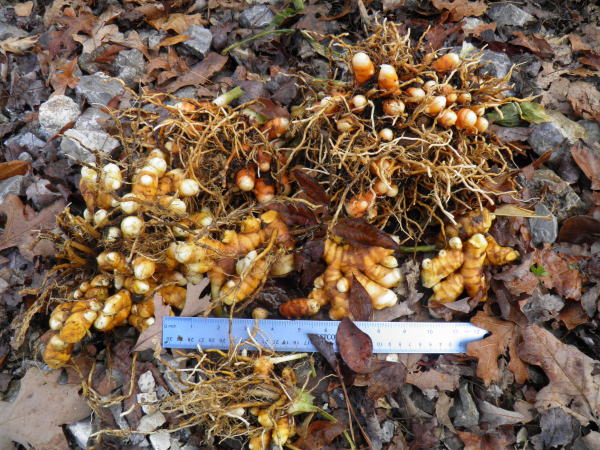 Late Nov, 2015: I harvested turmeric on Nov 26.
Late Nov, 2015: I harvested turmeric on Nov 26.
Three of the turmeric plants grew over 4' tall. The biggest one even got a big flower cluster, although supposedly turmeric can't be grown from seed. I didn't happen to notice any seed.
The 4th plant was shaded by 2 big ones and remained much smaller. It hardly produced anything; the cluster below the ruler in the pic was from the 4th plant. The stuff above was from the other 3.
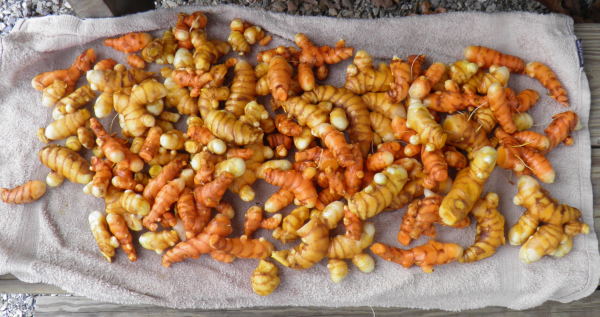 It was a big hassle to clean. In warmer climates, people leave some plants in the ground over the winter to grow the following year. But I don't think I'll grow 2nd-year roots again. The differences I noticed:
It was a big hassle to clean. In warmer climates, people leave some plants in the ground over the winter to grow the following year. But I don't think I'll grow 2nd-year roots again. The differences I noticed:- The offsets were often like stubby little toes that were all cramped together, meaning I had to break them off in order to clean the dirt from between them.
- Many of the tubers had tough, stringy feeder roots coming out that I had to tear off.
- Some of the pieces have an unusually bitter taste.
I don't know why many of these roots are oddly pale.
Turmeric sure has an orgoney vibe.
After leaving them spread out in a dry room for several days, I put some of the tubers in a breathable bag for eating over the next month or 2. The rest I cut (if necessary) into moderate-sized pieces. Then I let them air-dry for 24 hours so that the ends were no longer moist. Then I put them in a freezer bag and froze them.
Next year I will probably just buy roots in March and pot them up and keep them indoors until planting time.
My squash did fairly well. Some of the leaves got ragged-looking and attracted some very small, dark insects. The fruit often had beneficial soldier bugs standing on them, guarding them.
The plants ran out of oomph much too soon. Next year I will try to plant a 2nd crop in July in order to extend the production.
I did dry and save a fair bit, but not as much as last year.
2016: Aug 11, '16: This year we had an earlier start to the summer heat, so I pulled the row cover off a month earlier than last year. And just today saw my first squash bugs: several tiny grey ones sitting on a squash I harvested. First I've seen in 5 years, I think.
But I have been enjoying a huge crop of yellow squash. I have been drying a bunch for winter, eating some, but still have to give away a bunch. I planted twice as much as I thought I'd use, because it is a risky crop that can go wrong.
I also planted 3 spaghetti squash from seeds I took out of a commercial one last winter. Very vigorous, sprawling vines with surprisingly big and fast-growing fruit.
Turmeric: this year I bought a pound in March, planting them in little pots on 3/23. But by 5/8 when I transplanted them outside, none had sprouted. I didn't notice the first little sprout until 6/23, 3 months after I had potted them. (I also ate my first squash the day.) And even now, many have not come up, and the ones that have are small.
I did have a couple volunteers (tubers apparently accidentally left behind last year) come up in a bed very early, maybe early May, and one of these has grown well.
Also had a terrific, early crop of cantaloupes. Normally here they ripen sometime in Aug, even late Aug sometimes, but the first ones this year ripened early in July, with plenty of perfect fruit. I only had to throw away 4 that got ruined by heavy rain. And there are more fruit coming along.
This year I bought a chipper-shredder just to create mulch/compost, and I have ground up many cubic yards of chips containing a lot of leaf matter, This make a huge difference.
Aug 26, '16: Amazingly, I have seen no more squash bugs. But I was bedridden and was not able to harvest for over a week, during which time we got more heavy rains. So my yellow squash production cratered after that, but I have a few fruit coming along. A few plants are dead or dying.
Turmeric: got some smallish plants coming along but very slowly. But the Spaghetti Squash is putting out new fruit even this late; I presume these will end up a smaller size than the big ones that have been there for months.
Melon rant: I still have a few cantaloupes coming along, but haven't harvested one in weeks. A couple days ago I was in a grocery store and spotted some real nice melons. It had probably been a couple decades during which I had not tasted a commercial melon. I have during that time, several times grown Jenny Lind cantaloupe, an heirloom variety I love and save the seeds of. I only bought the seeds once. I really like these.
So anyway I bought 2 perfect-seeming melons at the store. One cantaloupe and one honeydew, both much larger than what I grow. Yesterday I cut open the cantaloupe. It was perfect in every way, was my initial impression. Perfect, even ripeness. Great aroma. The first 2-3 bites tasted terrific. But as I ate more of it, I could no longer taste any melon flavor. It tasted like pure sugar. It was so sugary and otherwise flavorless that I had to force myself to eat most of the first half. I hate wasting food. But eventually I realized I was only poisoning myself with such ridiculous amounts of sugar, and I put the rest in the compost.
So this morning I cut into the honeydew. It also was "perfect" and not quite as sweet. I managed to eat the 1/2. I will probably eat the other half tomorrow. But only because I hate to waste food. It is also too sweet. But at least it has melon flavor.
Now I know melons are supposed to be sweet. In decades past, it was more of a concern that melons I bought be sweet enough. A melon that is not sweet does not taste good. But now they have apparently hybridized these varieties to be intense sugar-bombs. Americans crave heavy sugar in everything.
The grocery store in Marshall often carries a few organic veggies. Years ago a couple times I bought organic parsnips there. But they, too, were inedible unless you are making a pie with them or something. Way too sugary to put in a veggie stew. Ordinary parsnips taste pretty good to me, but the commercial ones tasted more like super-sweet fruit than a root.
Dec 5, 2016: I harvested my turmeric late Nov. Only got maybe a couple pounds yield. Some of my plants produced little or nothing, possibly due to excess shade where I planted them. But the flavor! I have always liked turmeric but never really quite regarded it as an exquisite gourmet delight until now. No bitterness at all. Even just smelling the aroma when cutting it up is heavenly.
In fact several things I grew had exceptional flavor. The spaghetti squash which I grew for the first time tasted better than the origininal store-bought organic squash I took the seeds from. (I plan to grow about 4X as much next year.) My yellow squash which I grow every year tasted about the same fresh, but the ones I dried for winter use taste just as good as fresh, whereas normally the dried ones taste inferior.
Wracking my brain about what I did differently this year, the only thing I can think of is that I used about half a gallon of Neptune's Harvest fertilizer, which seems to be an excellent product. And I only used a relatively small amount for numerous squash plants plus turmeric, tulsi, etc.
Also, I bought a chipper-shredder in the Spring and chipped up dense thickets of saplings for mulch, which I used on the garden, even working a lot into the soil mix. However, it wasn't even well composted and I feared it might ruin the flavor of the squash. So I doubt the flavor improvement can be attributed to that.
Dec 23, 2016: I was going to mention how well freezing works for preserving turmeric roots. The turmeric I grew in 2015 turned out 2 ways: some was orange with good flavor, and some was pale yellow and very bitter. After freezing, the flavors remained the same. I ate all the dark ones, but most of the yellow one are still in the freezer. I might feed them into my worm bin gradually.
So this year, I harvested only pale ones (even though the bought tubers I had planted were quite dark and reddish). For 3 weeks I ate from these almost daily, and all the tubers were of excellent and mild flavor. Then I put them in the freezer because they were starting to dessicate too much. And all of them turned bitter! Every one I have eaten since tastes like the bitter ones from last year.
I don't know why. Perhaps the ones last year froze in the ground, causing the pale ones to turn bitter before harvest? Seems unlikely since last year we did not get any hard freezes before harvest, and this year we did.
I have searched online for info on which chemical makes it bitter (it might be a desirable antioxidant or something) but found nothing helpful.
October, 2017: I did not plant turmeric this year, but I do have a smallish volunteer plant.
I did plant CHAYOTE though, an unusual type of squash. I had eaten it a few times in FL in the late '70s and remember it was tasty. So I read up on it and last winter bought 2 fruit at a grocery store. One plants the entire fruit, which only has one seed, which requires the nutrients in the fruit to thrive. One plant is supposed to be enough for a family of 4, but I bought 2 in case one was not viable. In fact, one has only grown a tiny fraction as much as the other.
The fruit sprouted vines over the winter, and I planted them when the ground was warm enough.
I battled squash bugs all season on my other types of squash. I had planted them too soon, before the squash bugs were gone. But the bugs never messed with my chayote. Even after the plants died late in the season, none of the bugs migrated the few feet to the chayote.
All parts of the plant are edible and nutritious, even the starchy tubers. And if you can keep the tubers alive over winter, they will produce plants the next year. They are a bit cold-sensitive, though.
In fact they are supposed to produce an earlier crop from the tubers. The first year, the plants flower very late. I did not spot a flower until Sep 26! And I spotted the first fruit Oct 9. Ate the first fruit Oct 12. Yummy. Even tasty raw; reminiscent of cucumber but different.
Subsequent years should have earlier crops, providing I keep the tubers alive.
Pic was taken Oct 27, just before the first mild freeze. The bummer about chayote vines is the slightest frost totally kills them. So it's a gamble this far north. If it had remained above freezing a few more weeks, I would have gotten a decent crop. The vine was just starting to flower prolifically.
I got about a bushel of fruit in all.
But part of the problem is that this is a first-year crop. If I keep the tubers alive I will get fruit earlier next year. That's kind of dicey this far north too, but I am building a big compost pile over the tubers. Hopefully voles won't eat them.
Another idea is to dig up a few tubers and overwinter them indoors. But I could find no mention of this practice online for chayote, and don't know if it would really yield an earlier crop than planting a fruit. Seems it should, if you did it right.
I tire of the taste of chayote more quickly than summer squash or spaghetti squash. I can eat it 3X a week compared to 5X of the other squashes. But it is also good to mix in with other squash, or raw, with cucumber which it sort of resembles.
The cold nights have also dried and curled half the leaves on my fig tree, which has a bunch of green figs. They seldom ripen.
I did not hassle with growing turmeric this year.
July, 2018: The chayote did not come up at all. I had built a rather good-sized compost pile over it, which I scraped back in the spring, but nothing made it. We did have some zero F weather in the winter, and searing winds which killed most of my garlic, leeks, and shallots. Except for a bunch of shallots I had in a bed with sides much higher than the soil.
It also knocked all the leaves off my privets which normally are evergreen.
I found out the hard way how to measure soil pH: use cheap pH strips. I had a cheap meter as well as a reagent test kit, and they agreed WRONG, told me that peat moss was pretty neutral, etc.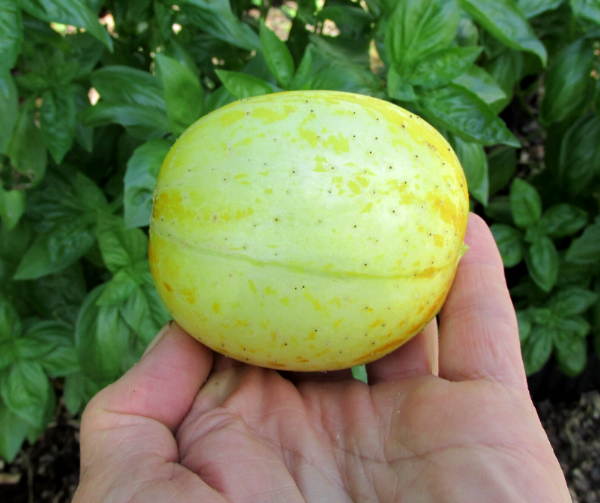
I have a bunch of lemon cuke vines, and have started eating regular cucumber salads as well as juicing them in a low-speed juicer. Normally they only get to be about 2" (and I get a lot of tiny ones too) but this one was 3" by 2.75". And I got another one like that a few days later, plus some smaller big ones.
July 12: Noticed blister beetles on my tomatoes and chard. Had not had a problem with them for many, many years. I added some homa ash to my diatomaceous earth squirter and dusted the plants some but there were a few more the next morning.
Worse, this morning I noticed squash bug eggs and a couple squash bugs. I had deliberately waited until the 2nd week of June before direct-sowing squash seed, in the hope that last year's squash bugs would have died off or move on by then. Evidently, it was either not late enough or else more came in from elsewhere. Which means I can anticipate a season of daily inspection/removal of seeds and spraying bugs with soap, if I want much squash.
July 27, '18: I have been getting plenty of squash. I have only been getting a few squash bugs and eggs, not enough to matter as long as I stay on top of them. Except that today, they had made it to my other garden 50 yards away, which also has squash as well as a bunch of lemon cukes. I was surprised to see several mature squash bugs on a few of my cukes, as I had never seen them on my cukes before, although they are reputed to go after cukes and melons. I have never seen them on melons [did see one such later in the season]. Plus, I saw 3 stink bugs on my cukes, another first.
I think these mature squash bugs must have come from somewhere else than my first garden, because I have only seen about 3 mature ones there, none recently.
There were also a couple squash bug nymphs on the squash in the 2nd garden.
As for the blister beetles, and a few hornworms I also had minor problems with on my tomatoes, within a week I had them pretty much picked off although a new blister beetle or 2 and maybe a hornworm show up on occasion.
I have not done agnihotra/homa in several years and need to make some more ash.
I have been getting quite a few oversize lemon cukes, some as large as the depicted one and one was even significantly larger. This despite a prolonged dry heat wave (cukes don't like it hot). Was it the small amount of M-state stuff I sprinkled on where I planted the seeds? Or was it the layer of rich compost I put on top once the plants were established? Maybe the highly-aerated weed tea I irrigated with many times?
I do get a few tiny, more bitter ones but not nearly as bad as last year. Last year I did none of those things and had mostly stunted cukes with "spines".
Been getting a few cantaloupes too.
Aug 30, '18: I actually did not have much of a pest problem this year. Haven't seen a blister beetle in several weeks. Delayed effect of the homa ash?
Had almost no grasshoppers. And only this morning did I notice a serious infestation starting to happen of squash bugs -- of the soft grey nymph stage. I have been getting less diligent about close inspection as the season winds down. The Horn of Plenty hybrid squash I grow produces prolific quantities of beautiful and tasty crookneck squash, but always fizzles out after about 2 months of heavy production, regardless of weather, fertility, and water [actually, turns out that the few plants I grew right next to the big compost pile produced much longer, and were still producing a few fruit in mid-October!]. So I like to dry a bunch to eat the rest of the year. I had the best year ever and dried a large quantity of squash chips.
The Park's hybrid spaghetti squash seeds I tried produced amazingly sickly plants, but fortunately I grew 10-12 plants of this. 2 turned yellow and wilted away before they set a fruit. The 3rd yellowed and died not long after, but had made several fruit, some of which were of decent quality. The fruit seem to continue to draw nourishment from the dying plants.
The rest all wilted one-by-one too soon, too, whereas the crookneck squash planted in the same row thrived. But because I planted so many spaghetti squash, and they made fruit before declining, I ended up with a decent amount, most of which are still ripening on half-alive vines.
Regular spaghetti squash plants which I grew in past years were far more robust.
I had the best year ever for basil, too. I still have several productive plants. I eat mountains of basil-tomato-cheese salad as the only raw greens I get in the summer.
Tomatoes did well. I have not seen a hornworm in several weeks but I have several times seem limited sectors of hornworm damage. I also often see little birds flutter away from the plants as I approach. I suspect my little hyperdimensional allies are alerting the birds to the locations of the hornworms.
Lemon cukes: I planted way more than ever before, and ate lots of large cucumber salads with kefir dressing, and drank a fair bit of cuke juice.
Aug 31, '18: Today I ripped up 3 mostly-spent crookneck plants from my east garden, to make room for planting some daikon, turnips, and kale. If we don't get a bunch of 95 degree weather in Sept (as happened last year) this should turn out well.
The interesting thing is, yesterday I saw a number of the soft grey squash bug nymphs on some of these very plants, and only made a perfunctory effort to squash the easiest ones to reach. These were the first squash bugs I had seen in that garden for weeks, despite a hasty check several times a week. And today, they were gone again! I noticed none on the plants I ripped up. Didn't even notice eggs, but I did not scrutinize deeply.
So evidently, as I suspected, something is killing my squash bugs! Sometimes, anyway. The nymph stage is very soft and succulent, and does not have a high concentration of the stinkum that the adults have.
Then I went to my south garden and did see some of the nymphs again.
In summation, I think the policy of planting squash late is worthwhile. Even if some new squash bugs fly in, they hopefully will not be plentiful. And the plants don't survive a long season anyway.
November 6, 2018: I did get a few more hornworms later. Grasshoppers got heavy in my east garden and lacerated my kale there, but it will grow anew. I've been eating small daikon.
November 10: The first freeze of the season was a hard one. Got down to 15 F last night.
April 30, 2019: Strawberry plants have set fruit, as has the potted blueberry I bought last year. Comfrey growing well with flowers and some bumblebees. Been eating nettles, shallots, wild onions.
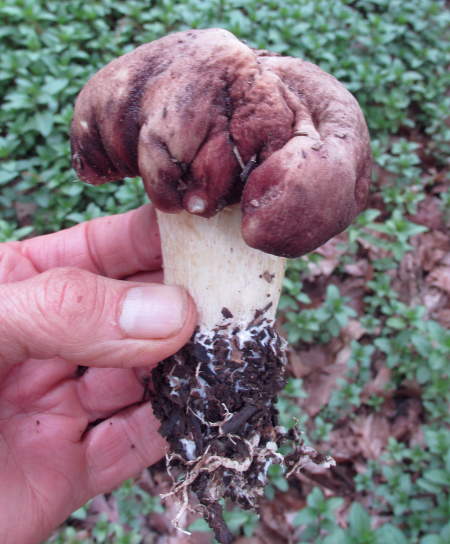 And, after almost 14 months of colonization from spores, I found my first Wine Cap mushroom! In early March of last year I had planted in wood chips some spores I got from Fungi Ally. Supposedly this will now produce prolifically and spread wherever there are wood chips.
And, after almost 14 months of colonization from spores, I found my first Wine Cap mushroom! In early March of last year I had planted in wood chips some spores I got from Fungi Ally. Supposedly this will now produce prolifically and spread wherever there are wood chips.
I have given up on bothering with onions and leeks in favor of simply maintaing a large shallot bed. I have a 4X8" raised bed packed with 2 types of shallots. They are just in the stage now where they resemble scallions or small leeks, and I pull up a few of the thickest ones to eat.
Also starting last spring I have been re-planting wild onions in areas with rich, composted soil. These become fatter than left in the wild and I pull up a few of those to eat too.
Lettuce is producing well, basil plants are getting established, beans have popped up. Tomato starts are growing well in pots.
My kale had almost died while I was gone last winter and there are only 6 plants now coming back into production (and starting to bolt, too). I planted more when I came back in early March and these are soon to be at a pickable stage.
Mint has popped up but the flavor is somewhat bitter, presumably due to the big rains we have had this month. I got 10.5" and will get more today and tonight.
June 13, 2019: That first mushroom was ugly but I got a couple more little flushes of prettier ones. Many of these were spoiled by excess rain but I ate some, dried some, gave some away, and tossed the rotten ones in other areas that have wood mulch. This mushroom only fruits when it is below 70 F.
My lettuce got stressed from all the rain and fog, and for the first time cabbageworms got into them and munched them down, killing a few plants. After trying things which proved insufficiently effective, I read that sprinkling cornmeal is the thing to do. They eat it, it expands in their stomach, they die. This did work! It totally killed off the worms and the surviving plants have taken off again.
One noteworthy discovery is that the celtuce I planted along with the lettuce was relatively unharmed by the weather and untouched by the worms. So next year, more celtuce is planned.
Today I was able to get a hold of more lettuce starts and planted them.
The basil was also stressed to some extent and a few plants died. Now I am trying to start more from cuttings and also have some little starts going from seeds.
I am about to plant squash seeds any day now. And today I transplanted some of my tomatoes from 2-gallon pots into big ones. Cuke vines have started growing, but no flowers yet. And rats or something have been eating the bottom few inches of many of my bean vines.
The TriStar strawberry plants which I planted last year put out prolific runners all season, and I expected more this year, but not one so far! Damn, I had plans for them this year. The plants did produce a huge crop, but the flavor was weak due to excess rain and I ended up composting most of the fruit as it was ruined by bugs and/or mushy. And now production has halted although they are supposed to keep bearing. However I also refrained from fertilizing them this spring.
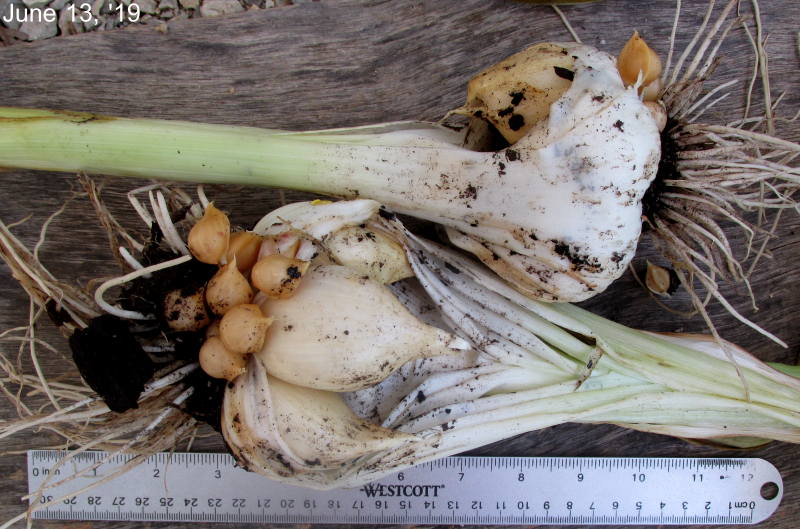 As I mentioned last July, searing winds had killed most of my garlic that winter. The garlic that survived, however, never put out scapes (seed spikes) which is unusual. I pulled them up when the leaves were dying and found that the bulbs had not visibly separated into cloves. They looked like small onions. These I kept and re-planted last November. I also planted some other garlic cloves. Many of the latter did not survive or thrive this winter either, despite having higher walls on the beds. However the big round bulbs from the previous winter grew into abnormally hefty plants. And today I pulled up a couple whose leaves were dying.
As I mentioned last July, searing winds had killed most of my garlic that winter. The garlic that survived, however, never put out scapes (seed spikes) which is unusual. I pulled them up when the leaves were dying and found that the bulbs had not visibly separated into cloves. They looked like small onions. These I kept and re-planted last November. I also planted some other garlic cloves. Many of the latter did not survive or thrive this winter either, despite having higher walls on the beds. However the big round bulbs from the previous winter grew into abnormally hefty plants. And today I pulled up a couple whose leaves were dying.
This is the size, behavior, and appearance of Elephant Garlic (which requires 2 years to grow) however, I have never tried growing Elephant garlic; this is Spanish Roja softneck garlic! Weird.
The little bulbils hanging on can be planted in the fall. As can some of the extraordinarily huge cloves, which will probably make for some tougher plants.
June 18, 2019: The celtuce stems I harvested today are bitter and inedible. Last year under similar conditions they were delicious.
Planted some soaked squash seed on the 15th and more today.
July 8, 2019: Normally July and August are the hottest months here, but I doubt it has hit 90 F yet at my place.
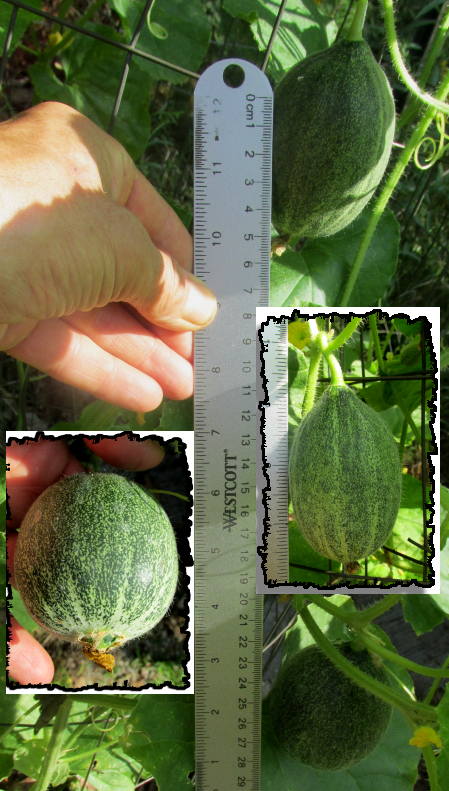 Last year I wrote:
Last year I wrote:I have been getting quite a few oversize lemon cukes... This despite a prolonged dry heat wave (cukes don't like it too hot). Was it the small amount of M-state stuff I sprinkled on where I planted the seeds? Or was it the layer of rich compost I put on top once the plants were established? Maybe the highly-aerated weed tea I irrigated with many times?
So this year I did not add such things at first. I have been eating cucumbers a while now but have only gotten small ones. So a few days ago I put a bunch of rotted-leaf compost on the plants (but it was less rich and broken down than last year's). This did not seem to make a fast difference.
So yesterday afternoon I added a small amount (1-2 heaping tsp) of M-state powder on top of the mulch on each 27-gallon planter and watered it in well. Coincidentally already this morning I saw a bunch of oddly oblong fruit, some rather large, forming (as well as the one large round one), that made me wonder if I had accidentally planted some cantaloupe seed, as the small cantaloupes start out oblong. I conceivably could have as I save seeds from both and they look alike. Hopefully not, I thought, as then I will have to yank these vines out because I can't protect them from the inevitable critters where they are.
Also the leaves of the oblong fruit are different. I am not growing cantaloupe this year as it is so difficult and laborious (and only partially effective) to fight off the animals who are attracted to it. So I could not compare appearance.
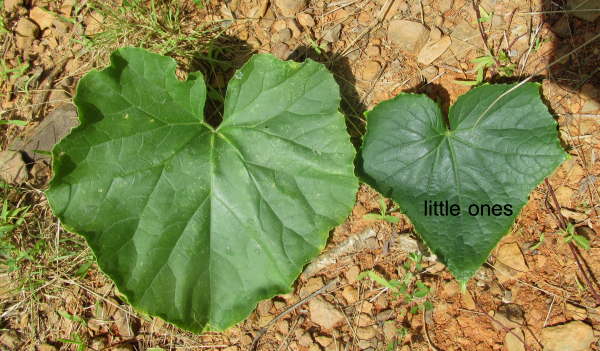 But the ones with the large fruit have the more rounded leaves (left) whereas the vines with small fruit have the more angular, pointy leaves. (The leaves are not smaller in general.)
But the ones with the large fruit have the more rounded leaves (left) whereas the vines with small fruit have the more angular, pointy leaves. (The leaves are not smaller in general.)
Having decided these must be cantaloupes, I proceeded to yank out :-( 3 of the smaller such plants. Then out of curiousity I bit into one of the small oblong fruit, and found it looked, smelled, and tasted like perfectly fine cucumber. Then I grabbed the depicted rounded one and bit into it: cucumber.
So evidently I have 2 strains of lemon cuke going! I did plant seed 2-3 times this spring in case the earlier planting got harmed by cold weather. And I have 2 stashes of seed, one purchased and one saved. Sometimes the seeds I save are totally flat and seem to have no meat, so I have bought more online. Then I'll have a years where I get good-looking seed.
So now I will plant a few of the store-bought seeds to see if these are the good ones.
Funny though that I never had such oblong ones before.
All the roja garlic (regardless of size) that I had planted matured weeks before the strong white garlic from the grocery store, which I pulled up a few days ago.
Strawberry patch still not doing anything. I put some old coffee grounds on it a few days ago and we will see if it picks up.
Kale is about shot but got some nice chard in a container.
Tomato plants have green fruit.
Been eating lots of basil and occasionally some lettuce.
Got several small squash plants taking off.
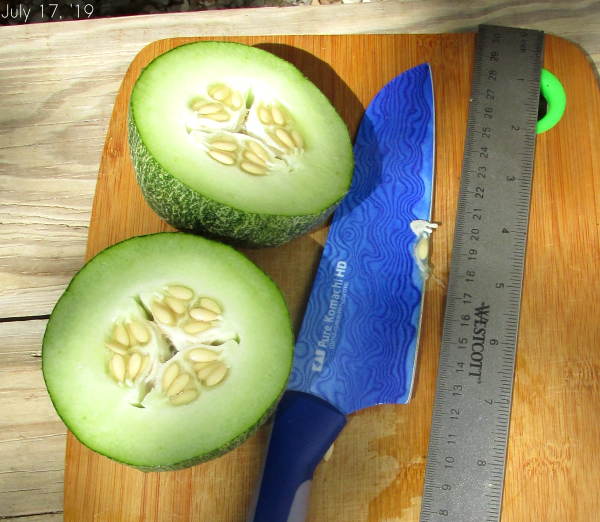 July 17, '19: I harvested the biggest of those cukes. Apparently they grow to a certain size (which varies) then stop and just hang in there tightly. It is difficult to break them loose from the vine even though ripe. Which is kind of good considering how heavy they are.
July 17, '19: I harvested the biggest of those cukes. Apparently they grow to a certain size (which varies) then stop and just hang in there tightly. It is difficult to break them loose from the vine even though ripe. Which is kind of good considering how heavy they are.
This specimen was 3.5" in diameter. I will be saving seeds!
Evaluation: tough seeds should be removed unless juicing. Rind is of pleasant flavor and texture but hard and chewy. Flesh has pleasant mild cucumber flavor with no bitterness.
Due to the presence of tough seeds and rind, probably best juiced.
Lemon cukes do not keep well at all. They deteriorate some in a day whether refrigerated or not. Unless picked when they are hard and yellow but less tender and tasty. This is how they sell them in farmer's markets. However these mutants will likely keep much better. I will experiment. I just picked the rest of the apparently ripe mutant fruit, using clippers to cut the vines, leaving a stem, instead of popping the fruit off.
This is real strange. Some background facts: [DELETED. See Aug 18 entry. These are cantaloupes.]
Also ate my first tomato of the season; very good.
I googled lemon cucumber mutation but the only thing I found was this post about a ribbon-like stem. I also have this on one of my plants which produces ordinary cukes. It flowers in dense clumps. I have never seen this type of stem before.
July 23, '19: Those big ones I cut off on the 17th were all soft to the touch by the 21st. I juiced them on the 22nd and 23rd, and they still provided ample delicious juice.
This keeping quality might be the only advantage of these mutants. Disadvantages:- Not conveniently suited for salads or pickles.
- Hard to know when they have stopped growing. I found one more big one on the 18th or 19th, and this one plucked easily off the vine, suggesting greater maturity. But the more clingy ones also had very tough seeds and skin. Right now, in terms of the mutants, I just have a number of small ones on the vines. I do not know if any of these will grow more. With regular lemon cukes, it is easy to see when they need to be plucked as they change appearance.
On the other hand it seems less critical with the mutants if they hang on the vine past maturity.
Picked my first little crookneck squash today, and have more that should be ready tomorrow. Interestingly, when the plants were only about 1 ft tall, I noticed 2-3 plump grey squash bug nymphs on them, and squished them. It seems unlikely these would have been drawn from afar by a few tiny plants (especially at nymph stage!) so I conclude that these survived from last year's eggs. I planted squash probably later than ever but there were still some of the bugs around.
Yet, I have seen no more since. I do peek at the undersides of the leaves daily, at least some of them. Also I only found one or two stink bugs so far.
So far no blister beetles or hornworms. No recurrence of cabbageworms.
July 29, '19: 3 days ago I noticed a bunch of squash bug nymphs and eggs on one plant, and got rid of them. Seen a squash bug or 2 lately too, not too bad. Yesterday and today found a bunch of smallish hornworms on 2 tomato plants. My etheric allies that are supposed to handle them haven't been on top of it.
The weird cukes have been growing fast and now I have a bunch the size of small cantaloupes.
Strawberries still doing nothing.
Aug 18, '19: Well, it turns out the 'mutant cukes' actually are cantaloupes I had accidentally planted (the seeds look the same). But this is a fortuitous accident. I had given up on growing cantaloupes because the aroma strongly draws in hungry animals, but actually they are juiceable and digestible at any stage, and taste like cukes early. But now, later in the summer, taste more like cantaloupe even underripe. And I just ate one that I had plucked days ago and left on the floor. It started to emit a faint trace of the raunchy odor of ripening cantaloupe. It tasted fine, less sugary and aromatic than a ripe one, but it had the right consistency and a fair bit of the melon flavor. I gave my turtles each a piece and they went right for it eagerly, whereas they tend to ignore cucumber slices.
So now I intend to keep growing cantaloupes and just harvest them before they reek.
Found another hornworm on the 1st and then 4 yesterday and 5-6 more today.
Record quantities of summer squash, giving away gallons and dried more than I am likely to eat; still have a bunch from last year. Just a few squash bugs occasionally, and a few stink bugs. Some heavy aphid infestation in one area. A few squirts of soap solution keeps them in check.
Might end up with record quantities of tomatoes, too. Many have been ripening but more still green. This year I have been jiggling the cages to get the flowers to self-pollinate, often resulting in grape-like clusters of smaller tomatoes but also more meat overall.
Basil has been awesome. Perpetual chard still putting out nice greens. Cherokee Black beans are my new favorite beans; very productive and well-behaved, easy to shell.
Mint not doing that well this year, presumably due to the rain. Then I let it dry up pretty well before watering again.
Aug 21, '19: I have been finding more hornworms. They say that hornworms are parasitized by trichogramma wasps which hang aroung small-flowering plants. Well, I see plenty of tiny wasps on my oregano flowers etc but never ever have I seen a hornworm that appeared diseased or parasitized.
This year, having tired of spaghetti squash, I decided to try Uchiki Kuri winter squash instead. It is a vigorous, healthy plant and has already produced several rather large round orange fruit as well as many more still developing. Nice and fine except that it is still putting out lots of flower spikes this late in the year, whereas I already have way more fruit set than I can use. I broke off about 150 of the spikes this morning but there are many more. I think next year I will shoot for ONE of these plants and 3 of summer squash instead of becoming a squash slave again.
I juiced a bunch of the yellow squash and did not find it very palatable fresh, BUT it makes excellent watery kefir; a light, fizzy, slighty acidic drink which goes down very nicely.
Otherwise the raw juice or squash makes me nauseous; presumably I am sensitive to the saponins in them.
In the last few days I have been watering many things with a very rich, dark, slimy, heavily aerated weed brew made with lots of lawnmower clippings -- for the first time this year.
We have had several days in the low 90s but today is supposed to be the last hot day. Got a T-storm with 1/2" last night but it has been dry otherwise.
In the heat, cuke production slowed way down; we shall see if the cooler weather and ample fertilizer brew jump-starts them again.
Chard and basil still doing very well. Still getting a few beans but their trellis is being overwhelmed with winter squash vines now.
This page has gotten much more elaborate lately, largely as a reference for myself so I don't forget details and lessons I learn.
Oct 10, '19: My summer squash plants have all been ripped out.
Red Kuri squash review. They say to harvest in Oct but I did harvest a couple in Sep. They have a nice flavor but not much meat. The fruit are very large, larger than most winter squash, but it is mostly a seed cavity and the meat is only about 1" deep (actually often more like 3/4") along the periphery. At least that's how mine turned out, and they had plenty of compost, water and warmth. Other winter squash I had grown never turned out like this.
I went out this morning to check on them and found 3 in one spot that were covered with large squash bugs! which were feeding on the fruits. The skin is quite thin on these squash, which is nice for slicing and cooking/eating, but offers little resistance to adult squash bugs. One was so perforated I had to throw it away.
The vines keep flowering and setting fruit even this late. And the flowers were packed with hundreds of little green/brown Mexican bean beetles munching down on them. I sprayed soap solution into the flowers.
I had planted some cuke seeds much later than usual, and these have now produced several big cukes long after my other cuke plants have dried up -- worth trying again next year. The supposedly rich nutrient brew did not seem to help those earlier cukes, as they never recovered.
The last couple months most of my tomatoes have had some stink bug damage, despite my providing a spot for the planters on gravel, far from any weeds. This did work for a couple years but for some reason the bugs found the plants this year. I only saw very few of these bugs, yet the tomatoes appeared to have their signature on them.
The forecast is for 33F tomorrow night! Pretty cold for this early in the year. The tomatoes won't like that but then it may not get as cold up here.
I have found a few more hornworms meanwhile; seems my little allies are no longer addressing them much, inexplicably.
Planted a mess of kale seeds a few days ago, which are coming up nicely already. I will plant daikon in a couple days.
Still harvesting Black Cherokee beans I planted months ago. I really like these and may grow them yearly henceforth. Easy to grow and shell, and very tasty.
Those Mexican beetles were all over the beans and did a bit of damage, but the bugs seem to prefer the squash flowers lately. I harvested the squash but am leaving the vines to continue serving as a trap crop for these bugs.
Perpetual chard made it fine through the summer in an elevated planter where there is less insect pressure.
None of my strawberry plants put out runners that I noticed except one. And I got no further fruit, except a few.
The figs I grew in pots, one plant produced all of 7 delicious figs many weeks ago, whereas the other never did ripen its fruit, mysteriously. I had uprooted both as offsets early in the year and treated them the same. So I re-planted them in new spots.
Nov 19, '19: That 2nd fig did finally produce a few nice fruit 3 weeks after the first one.
I find that the Red Kuri squash is still not quite as much to my liking as the dried sumnmer squash, and gave more away than I kept. However, it is still pretty good for an occasional change, especially with adzuki beans. I do like it more than acorn or butternut squash.
I was away from home for 23 days, and toward the end it got down to 13 F here and fried my chard, and froze back the kale some. The olive trees appeared undamaged, and I pruned them back. [Update: they froze to the soil level and re-sprouted from the root the following July.]
Jujubes: I planted a Li jujube back in '98 I think it was, in a spot too hot and and dry. It never produced a fruit but in recent years has produced many root suckers which are easy to transplant. I transplanted 2 a year ago and several more this fall. Now I just ordered a Lang jujube for pollination.
Meanwhile the original mother plant has died, leaving a small thicket of thorny offspring up there.
Yesterday I planted 2 beds of ~25 each of my bizarre monster mutant garlic. Some of the cloves were 2-3X as big as normal elephant garlic! They should be meaty enough to produce good garlic despite any capricious weather.
Even planted one round one which had not split into cloves yet. It is about the diameter of a tennis ball, but not as tall. It has gone through 2 winters without splitting! How bizarre is that. I gave that one extra space.
Saffron: I had twice planted saffron bulbs but apparently the voles ate them. So this year I ordered more which I planted in pots so I can keep them away from the rodents as well as take them in during the coldest times of winter.
Pawpaws: I planted many from various sources in years past. Of these, only one still survives by my east garden. It seems to be doing OK and I mulch it heavily.
And, topside I had planted a native one which never produced (lack of water) and eventually died. But then several root suckers came up which I thinned and am nurturing along.
Serviceberries: I had also planted quite a few varieties from several sources, but have never been able to keep any alive for more than a few years despite everything. Never got a fruit.
Autumn Olives: In 2015 my Charlie's Golden autumn olive died, but then a couple sprouts came up from the roots, one of which I transplanted. Also years ago I had planted a red autumn olive off a cutting from my mother tree topside (which still is alive) and this lasted a few years before dying of drought before I had enough irrigation water and mulch. But then 2 sprouts came up from those roots, which I have been nurturing along with compost, mulch, irrigation, and should produce fruit next year.
Feb 25, '20: Some updates:
Jujubes: As I said, I transplanted a bunch of my volunteer jujubes to where they will be watered. And I planted a Lang jujube.
The volunteers were on roots running just under the surface of the ground. All I had to do was dig under them a little bit. They have no roots going down, so I just grabbed under them and yanked upwards hard, giving me a start with several inches on each side of thicker tree root. Then I dug little trenches to accommodate these horizontal roots.
Garlic is looking awesome! A couple times when temperatures dropped into the mid-teens I covered them with blankets. They already had welded wire fencing over the beds to keep critters from digging around.
Saffron: I had planted the best bulbs in a square container, and the rest in 2 smaller round pots. To my amazement, in Nov I got flowers with nice pistils from all the ones in the square container! When planted in the ground I had only ever got 3-4 flowers total for all my efforts, and this took a year's growth. I put the whole flower in a pot of squash I am cooking.
Oddly, none of the ones in round containers flowered, although mostly they had not much smaller bulbs.
Serviceberries: I talked to an expert and he says they like acid soil. I had not known that, and amended with wood ash.
If you are an old-timer like me, you can remember how easy it was to grow SUNFLOWER sprouts in the 80s. You go down to the co-op and buy a bunch of raw, organic unhulled seed sold for eating for $1.79/#, soak some for a couple days, and spread evenly over a substrate. After several days you get a dense forest of yummy little plants.
But all attempts at doing this these days turned out poor. I tried hulled seeds, but they did not sprout uniformly and I didn't get much. Apparently normal unhulled raw organic seeds are no longer available. All I could find was obscenely overpriced special tiny sprouting seeds which performed no better than the hulled ones! I tried this with seeds from 2 different seemingly reputable sources. Many of the seeds don't sprout, others barely sprout, a very small minority do grow into something decent (but certainly not better than in the old days), and some only grow an inch or so.
So this year I plan to grow sunflowers! In modern America, it is no longer possible to buy many useful things that there must be a demand for, that were readily and cheaply available in the bygone past. One must DIY, or improvise, or just resign oneself.
I saw a video on CHICKADEES the other day. I love chickadees because they have a sweet vibe and are fierce demon-hunters. Plus they eat a lot of insects off of my garden plants. The vid said they have a very high metabolism and need a lot of food to survive cold winters. Mortality rates can be up to 80% due to starvation in winter.
So I put some of my pricey sunflower seeds out with some cashew pieces. I had a bag of cashew pieces in the fridge that had been there for months, shrinking very slowly because they have inferior flavor. I put all this on a plate and put the plate on top of a grow barrel that was caged in welded-wire fencing that would not allow larger animals in.
Checked back in a couple days and all that was left was empty shells and some cashew pieces evidently too large for the little guys to manage. So I broke them up painstakingly by hand and added some more of the sprouting seeds. They ate that stuff up.
So another reason I want to grow sunseeds is to feed chickadees. Also I will be saving any winter squash seeds, of which Kuri squash produces plenty of.
I enlarged the fenced area of both of my garden spaces this winter.
Feb 28, '20: Today I planted a bunch of Gurney's Whopper strawberries and a Fuyu persimmon tree. Also a Tophat blueberry in a pot.
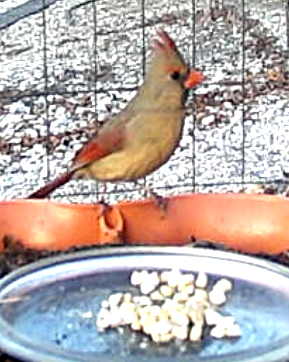 March 6, 2020: I guess all my chickadees died? It has been a milder than usual winter but I have not seen any in a while. I set up a trail cam by my feeder (with broken cashew pieces) and got several red (male) cardinals and this female Northern Cardinal. Well, cardinals are my friends, too, but I am sad not to see chickadees. Next winter I will start offering them food earlier.
March 6, 2020: I guess all my chickadees died? It has been a milder than usual winter but I have not seen any in a while. I set up a trail cam by my feeder (with broken cashew pieces) and got several red (male) cardinals and this female Northern Cardinal. Well, cardinals are my friends, too, but I am sad not to see chickadees. Next winter I will start offering them food earlier.
March 19, '20: The winter was so mild that the new leaves that came out on my comfrey in late summer survived and are now growing. Yet my 2 rosemaries died.
Today I received and planted 26 Boyne raspberries, which are supposed to produce a very early crop (so I can water them less in the summer). I planted most in my old garden topside which had not been used in a dozen years or more as it is too much hassle to water daily in the heat of the summer when ticks sometimes abound and snakes are out. Still, I will need to water these plants enough to keep them alive. Moreso for the first couple years. But the soil is amazing because long ago I put lots of aged sawdust on it, and it finally turned the clay into rich-looking (acidic) soil.
A few days ago I decided that my goji plants never produced because there is just not enough soil there where I put them. I transplanted a bunch of them.
April 10, '20: I was just admiring my comfrey bed and remembered, the leaves DID die back in winter, or at least got so covered in leaves while I was in VA that I could no longer see them. Then I added more leaves including several bags collected and chopped up by my mower. Then the rain and time caused the dead leaves to settle some, and comfrey leaves started poking out some time ago. I did not have any wood chips this year, so the mulch was fluffier and probably more insulative. Perhaps in the future I will only mulch them with dead leaves.
The plants are a yard high now and in full flower. Some bumblebees and other bees on them. Whereas the mint next to them has barely sprouted out. I have been plucking 2" high shoots for tea.
Meanwhile I planted a Hardy Chicago fig and Celeste fig. Have been eating fresh kale/nettle/houytunia greens cooked together.
May 24, '20: Been having excess rains like last year. I will be planting mint in a raised bed as it is again almost tasteless where it is now. I have been eating some strawberries, those that aren't rotting. But they don't have much flavor.
And once again, my lettuce is getting infested with cabbage worms, but this time the cornmeal does not phase them! though it seemed to stop them in their tracks last year.
Beans and some cukes have come up; whether they will thrive is in question. It has also been unusually cool for May.
June 21, '20: I resorted to spinosad for the worms. Next spring if it's wet I will buy some BT.
The heavy rains seem to have stopped after I got 2.6" on the 9th. I harvested my garlic yesterday, and much of it again did not form cloves! I read that this is common if one plants in the spring, but I always plant in November. I can't find any mention of it happening to fall-planted garlic. And we had a mild winter. It only got down to the teens twice after that first one in Nov, and both times I sheltered the garlic from the cold.
Also, the ones that did form cloves formed big elephant-garlic sized ones. The round ones are also mostly on the large size, billiard ball size. But then I had started with real big cloves last fall.
Today I added perlite, peat moss, compost, and mint starts to one of the 4X4' former raised garlic beds which should drain much better if we have wet springs in the future. Plus I can cover it if a big rain is expected.
I have good-looking bean plants and cuke plants going. Also a few sunflowers and a Sugar Baby watermelon vine.
And no more Wine Cap mushrooms. I got none last fall and none this spring. Their aggressiveness has been greatly exaggerated.
June 29, '20: I planted several yellow squash starts yesterday. This morning I noticed my first Japanese beetle ever, on a ripe wild blackberry.
Beans, cukes, chard, watermelon, sunflowers, grapes, tomatoes, basil are all growing well. Cukamelons more slowly. Noticed the Fuyu persimmon had set a golf-ball sized fruit!
July 5, '20: Ate my first cuke today. We have had scant rain in recent weeks, but high humidity and some drizzle. This morning I noticed some lettuce had cabbageworms again, sprayed spinosad again.
Even though I had waited later than ever to plant squash, I noticed one little start this morning bent over and rotting at the base. There was a big stinkbug there and a tiny squash bug nymph! already.
Meanwhile I have planted 2 red Kuri squash starts.
July 15, '20: I have never seen so many squash bugs on such small plants, even though these were planted so late. Large adults, nymphs, eggs. Now some of the eggs are even being deposited on the stems.
Also, even though I fried them radionically, Japanese beetles are still on my blackberry and raspberry plants, and now also eating the leaves of my Fuyu persimmon.
I decided to try something that used to be heavily promoted decades ago, but has dwindled into obscurity for unknown reasons. They even came up with a type of smoothie called Bug Juice, which is made in a blender. So if I google bug juice blender, almost all results are irrelevant. But I did find one relevant article.
I had a gutless plastic blender I had bought for $5 at a second-hand store, to dedicate to the cause. I whipped up a small handful of squash bugs. Discovered why the blender was sold: the gasket was missing so I got bug juice all over my counter. Subsequently I glued the base hardware together with silicone glue so it shouldn't happen again.
I took this juice and put it in a watering can, added more rainwater, and poured it over my small squash plants. Then poured a bit on my cuke and melon plants in case the adults hop to these.
I have a few Japanese beetles I harvested this morning. In a day or 2 I will get some more and blend them all up too. Then I will need to filter the crud out so I can use it in a sprayer.
If this stuff doesn't work I will need to do a homa fire to get some holy ash; I have been too lazy for many years to do that and have run out.
Also the pods of the beans in the east garden are infested with some tiny bugs. I sprayed them with a soap solution.
July 17, '20: Well! On the 16th I saw a few squash bug eggs on each squash plant, plus 1 nymph, no adults. On the 17th, just 2 plants had a small cluster each, no adults or nymphs.
On the 16th the Japanese beetles discovered my rose-of-Sharon flowers, and I harvested a bunch of the beetles. On the 17th, a few more. Then I whizzed them all in water in the blender, filtered, and sprayed, including plants they might spread to. They were starting to skeletonize my grape vine.
Been finding a few large stinkbugs; not many.
Getting a few lemon cukes now. Cukamelons are miniscule though. Yellow squashes starting to form. Black beans will be shellable soon. Left the 3 biggest sunflowers, and they are huge, like 7' tall.
July 23, '20: Well, the bug juice appears to be working! I have seen no more squash bugs at all, just diminishing little egg clusters. Today I noticed no eggs, even.
Japanese beetles? They gradually diminished so that normally the only place I find a few is on my Fuyu persimmon. I only found 1 today. Plus I have only noticed a couple more stink bugs. Maybe the radionics I did was effective. They haven't even made it to my tomato plants yet.
Black beans: been harvesting a few; shelled and cooked some yesterday. Harvested my first 2 yellow squash. Been eating a few cukes.
On a wild hunch I bought 1 Black Prince tomato start this spring, and it is the only one starting to get some blush on the fruit.
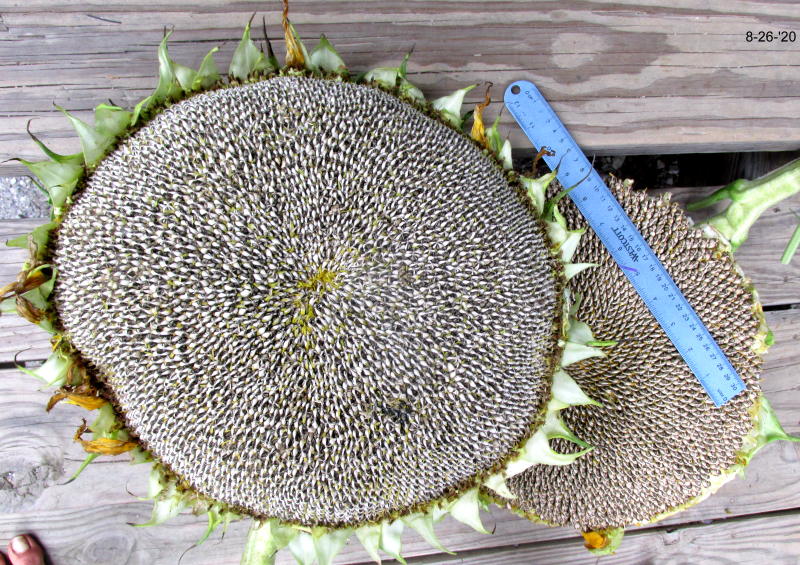 Aug 26, '20: Not bad for my first attempt at growing sunflowers. I grew 3 "Giant Titan" plants, and the 2 biggest heads were about 14" in diameter. I just cut them to finish drying indoors. They feel super orgonized, presumably due to the growing environment.
Aug 26, '20: Not bad for my first attempt at growing sunflowers. I grew 3 "Giant Titan" plants, and the 2 biggest heads were about 14" in diameter. I just cut them to finish drying indoors. They feel super orgonized, presumably due to the growing environment.
The flowers had long been facing downward due to their weight. They all had several large stinkbugs on top (the backsides of the flowers). Next time I will put diatomaceous earth on top after the backs become horizontal. I have also suddenly been seeing more stinkbugs, mainly on my cukes and a few on squash. So far not one on my tomatoes! Whereas in the last couple years they were always hanging out on my tomatoes and damaging half my crop. I think that the frequency I had been running for them, 47.84Hz square wave (or 48Hz square on a freq gen that does not do decimals), broadcast through orgone devices for hours at a time, may be the reason. I saw very few until a couple days ago. I had neglected to blast them for weeks.
Also saw my only hornworm 2 days ago, whereas normally it is impossible to grow tomatoes here without significant damage from them. It may be because I really pruned the plants a lot this year, growing narrow, thin plants up a stake. I suspect they are more visible to birds. The one I did find was on the only plant I left somewhat bushy.
Been seeing spotted cucumber beetles lately, primarily in the flowers of my Red Kuri squash.
Squash bugs have not been much of a problem. I still have not spotted an adult since last report, just a few nymphs and eggs here and there at times.
Japanese beetles faded away weeks ago.
It was a terrible year for basil. I set out many starts, but they all turned yellow, even though conditions were about the same as last year, in which they did fine. I do have a few little starts coming along, but don't know how much I can still get this late.
Lemon cukes, normally never bitter even under bad conditions, produced many bitter fruit despite rather ideal conditions.
Many of my tomatoes have green shoulders, supposedly caused by excess sun hitting the fruit. But I never had this problem until last year, despite growing tomatoes all kinds of ways.
The plants I pruned severely this year are in a spot where they get no direct sun from around 1-6pm, then get some in the late evening. Yet there are many green-shouldered fruit. Also the one bushy plant that does get more sun had such fruit in the densely shaded middle. Whereas some of the more exposed fruit ripen evenly.
In general, in my location, I am getting the impression it is better to have a multitude of skinny, sucker-pruned, tomato plants in 4 or 5 gallon buckets, under shade most of the afternoon. Yield per plant is low but they are easier for myself and birds to scrutinize for pests, and the water demand is much less per fruit, it seems. Plus there is less leaf-to-leaf contact to breed fungus when damp.
I can't recommend Black Prince tomatoes. They are fine unless it rains more than slightly. I had a 1.5" rain and every single fruit on that plant cracked, even though they were totally green and and small. Some were tiny! I have never had a green tomato crack from overwatering before, only ripening ones. I always harvest any fruit that are approaching ripeness before a big rain.
I also can't recommend cukamelon. I grew several plants and they are a complete joke. They mature late, produce very few fruit, and only a few ever attain to marble size. Most are the size of kidney beans. They do have a pleasant crunchy, slightly tart quality.
For that matter, most of the fruit on my lemon cukes don't get bigger than that in recent years, despite diligent irrigation and a mild summer this year. Not worth picking. But they also produce many medium-small fruit and a few unusually big ones.
The goji plants I transplanted grew well but did not set fruit.
My fuyu persimmon still has 2 green fruit on it. The Japanese beetles seemed only interested in the leaves.
The Boyne raspberries are growing well, and I even got a few dozen tasty fruit off them this first season.
I have a lot of cantaloups going, for juicing before they get so ripe that they attract fauna. The Sugar Baby watermelon ripened a long time ago; I plan to grow more small watermelons in the future.
I did get a big crop of beans and still have some on the vines.
I have small starts of bok choy, kale, and chard going, which I hope to put in the ground as soon as room is made by tearing out my yellow squash plants whenever they slow down too much.
BTW I used to promote tire planters but I have dismantled my tire beds. Tires contain heavy metals and they do break down and turn to black powder that smudges your skin.
August 29, 2020: In case anyone feels inspired to grow such huge sunflowers, I should mention a few things:- Sunflowers are very heavy feeders and drinkers. I grew them on improved soil rich in organic matter, and watered frequently, often with dilute urine. Mid-season I put maybe 1/2 a cup of blood meal around each one. I was out of fish emulsion, but that would have been good too. I don't have access to animal manures.
- They can't support themselves. I tied them off as they grew, to the same sturdy trellis I use for my beans and cantaloups.
- They grow tall, maybe about 9'. My trellis is only about 7' tall, so after they surpassed that and the heads got heavy, the stalks turned down into an inverted J shape, leaving the flowers facing the ground horizontally. One advantage is that the seeds don't catch the rain in that position.
- Sunflowers are very prone to predation by birds and squirrels. I had no such problems and suspect it was the inverted position of the heads that foiled the birds. And the squirrels did not notice them up there. Also the local fauna are likely unfamiliar with sunflowers. It is a different matter if you let unstaked plants fall on the ground where every rodent and bird can access them.
- Once the flower petals dry up, the seeds are more loose, so it is best to cut off the heads and finish curing them in a dry indoor space.
I found several more stink bugs this morning on my cukes and squash, and half a dozen or so squash bug nymphs.
And found my first little stinkbug on a tomato this afternoon.
September 10, '20: After 10 days I knocked off the sunflower seeds. They are still far from cured. The pads of the flowers were still moist inside and rubbery. And the seeds don't seem very plumped-out despite all the inputs. And they vary a lot in how much meat they have. These might not work well for sprouts. Probably to grow good seeds requires even more nutrition, like copious manure compost.
There is quite a volume of seeds, though, still drying.
I have seen no more hornworms since that one! No more stinkbugs since on tomatoes since the one, either. But every day I see a few on cukes, squash, and sometimes cantaloups.
Still see a few squash bug nymphs and eggs occasionally, but still no adults. I have seen 2 of those slug-looking tomato borers this season. But no blister beetles this year. And still no more Japanese beetles.
None of those Mexican bean beetles yet, but lately quite a few spotted cucumber beetles on my squash, cukes, and beans. These things at current levels don't do all that much damage to the leaves this late, but they spread bacterial wilt which appears to have affected the beans and cukes especially. Plus many of my bean pods have been drilled into, presumably by them. I still have a surprising amount of beans on the vine, and some are getting damaged. Next year I need to try yellow sticky traps. For now I just started blasting them with a frequency I am testing.
I have actually been eating quite a few nice cantaloups, and still have a bunch growing. No problems with critters eating them. Twice I saw piles of tiny rabbit turds nearby, but no damage. I mark the soulless rodent pests like that, and Eenia arranges an intimate rendezvous with a snake ally. There must be a few big ones in the brush near the garden, as I have noticed no rodent damage this year.
My current policy on growing cantaloups is:
1) Grow them up trellisses and harvest any low fruit early for juicing. That way rodents are less likely to even notice them.
2) After all these years of growing this variety, I finally noticed that the outsides suddenly turn a lighter color when approaching ripeness. At this point they separate from the vine easily and don't have much odor to attract animals yet, but then they will ripen indoors in a day or 2.
September 16, 2020: The freq I have been running several hours a day against spotted cucumber beetles, 78.068Hz sawtooth wave, does seem to have effect. It consistently results in an almost complete absence of these pests on my cukes, beans, and summer squash, but they still congregate quite heavily on my Kuri squash blossoms and leaves. So Kuri is a good trap crop to distract them away from other plants, but only if the freq is used.
As it so happens, I only ended up with 1 Kuri plant, and it is on the end of the garden away from the other affected plants. I planted it late and pruned it a lot, and picked off many later flowers, so I only have 3 ripening fruit and one juvenile.
Still seeing a few stinkbugs at times. Adult black ones were hanging out on top of my cantaloup fruit until I started spraying the tops with dilute soap doped with oils of pennyroyal and citronella. I still have quite a few little melons on the vine.
Temperatures have dropped some. My cukes have been fading and I have ripped out most of them. My summer squash is slowing down and getting lots of white mildew on the leaves. Rare squash bug nymphs spotted. I still have beans coming along. My tomatoes have only recently become reasonably laden with fruit, slowly ripening. Still only 1 hornworm and 1 stink bug seen on them. Some fruit damaged by grasshoppers and whatnot. Still no Mexican bean beetles.
I picked a few goji berries from the transplanted plants, which are doing better in their new locations.
Still no more Japanese beetles.
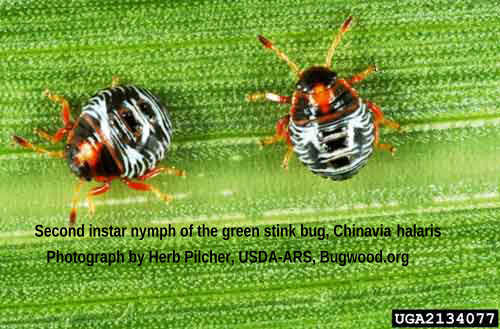 September 18, 2020: Pressure on the beans gets strong this late in the year. Now I have tiny gnats or something plus a bunch of these little guys eating the beans. Nymphs of green stinkbugs.
September 18, 2020: Pressure on the beans gets strong this late in the year. Now I have tiny gnats or something plus a bunch of these little guys eating the beans. Nymphs of green stinkbugs.
I dowsed a different freq for these nymphs than the stinkbug freq I was using: 144.439Hz, triangle wave. This lights them up!
Incidentally, my list of freqs is here, and I use NCHtoner run though an orgone device.
September 19: Amazing! I have been running that freq on and off since 28 hours or so ago. Went out just now to pick a few beans and saw ZERO of these nymphs!
Still a few black stinkbugs around, though, including young ones.
September 30, 2020: Late in the season the grasshoppers come out more. Noticed them partying in the east garden this morning. Dowsed 948.8863Hz, square wave for them, ran it most of the day. Not sure what effect, but there were much fewer of them around there after that.
But the cucumber beetles were very plentiful around my Kuri squash again, so now I am running that freq again.
A couple days ago, last I harvested some beans, I saw 6-8 of those nymphs again. I have not run that freq for a while.
I have most of my green starts in the ground now; but really it's still a bit early as there are still bugs out to eat them.
I harvested 3 nice cantaloups today! Unusual this late.
October 12, 2020: Been having wonderful weather last few days. Still getting tomatoes, beans, and cantaloups. Still have oodles of cucumber beetles, some of those stinkbug nymphs, a few big black stinkbugs loitering on my cantaloup fruits, and many grasshoppers, but the bugs are only active when it's warm. Not seeing much damage. I haven't blasted them in some time.
Been starting to get meals from my new bok choy, kale, and chard. Also the radishes and kale I had sowed from seed are coming up well.
Unusually decent fall crop of nettles.
My 2 Fuyu persimmons are getting some color to them.
I figured out, late in the season, to wrap the Kuri squash fruit with old scraps of row cover, and set them on carboard to deter the insects.
I had planted 2 nice hunks of turmeric root in the spring, in a sunny, warm planter with good drainage that I was growing beans and watermelon in. Only today, for the first time, did I notice that they had finally sprouted, with 5" long leaves! Maybe I will dig them up and keep them in pots over the winter.
My che trees fruited prolifically for the first time, but then sometime in September when my back was turned, the fruit disappeared. Need to monitor more next September.
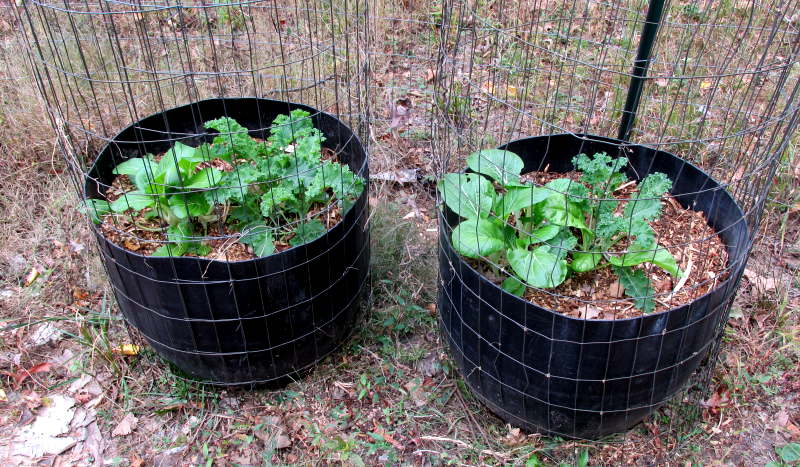 October 18, 2020: I have torn out almost all my bean vines and most of my cantaloup vines.
October 18, 2020: I have torn out almost all my bean vines and most of my cantaloup vines.
Oddly, no Mexican bean beetles this year; the stinkbug nymphs substituted for them.
Weeks ago after I ripped out my cukes from 5 planters I have like this, I spruced up the soil a bit and planted greens from my home-grown starts. By planting them in an elevated container I get far fewer grasshoppers etc so I can plant earlier. The disadvantage is that their roots will get colder up there in the winter and may die off. I'm gambling on a mild winter.
More recently as the bugs got less active, I planted more of the starts in this bed below, which previously had summer squash in it. All my starts had bok choy, kale, and chard planted together in the same pot. I will be able to compare how they perform in winter. I have already eaten several times from this crop. And bugs have not eaten much.
A few days later I also planted a few remaining starts in another bed, along with more kale and chard seeds, which have sprouted and are growing. Another bed has some red radishes and a few daikon.
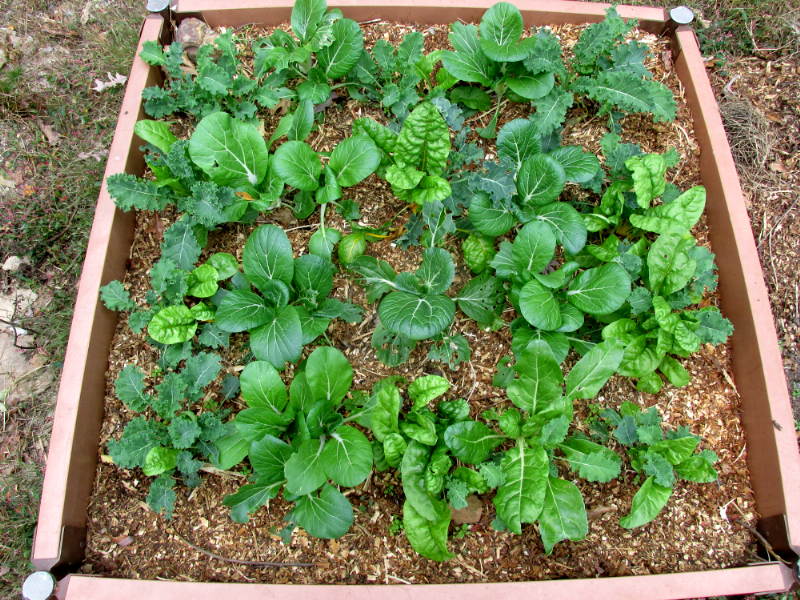 Yum. I eat a lot of cooked greens in the cool part of the year, and I really like these.
Yum. I eat a lot of cooked greens in the cool part of the year, and I really like these.
October 26, 2020: Colder weather now; drizzly today. I plucked my remaining tomatoes a couple days ago and brought them in to ripen. Yesterday I harvested the Kuri squash and unripe cantaloupe and brought them in. Also my 2 Fuyu persimmons which are almost ripe and had some odd little brown spots forming on the bottom.
Baffling glitch in the matrix, or what?
As I mentioned last November, years ago I had planted a red autumn olive off a cutting from my mother tree topside (which still is alive) and this lasted a few years before dying of drought before I had enough irrigation water and mulch. But then 2 sprouts came up from those roots, which I have been nurturing along with compost, mulch, and irrigation. And last November I transplanted a Charlie's Golden autumn olive near the new red ones. The Goldens produce orange-gold fruit like in this pic below. But, this a pic of fruit I picked a couple days ago from one of the red autumn olives:
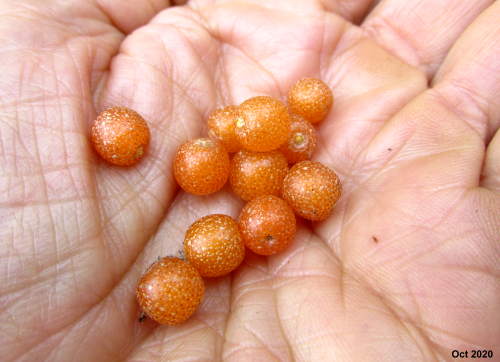 None of these 3 newish autumn olives has fruited yet, except the one red which produced 3-4 dozen golden berries. The mother tree and its mother have only ever produced red fruit.
None of these 3 newish autumn olives has fruited yet, except the one red which produced 3-4 dozen golden berries. The mother tree and its mother have only ever produced red fruit.
Is it possible that the small Golden which was a couple hundred yards north up a steep hill pollinated the mother I had brought down years ago, and that the volunteer red is actually a hybrid? Well, seems unlikely, but is the most reasonable explanation. They are insect-pollinated. I wrote last November that the volunteers came up from the roots, but that was an assumption and, now reading up on it, more likely some fruit fell off and sprouted seeds. Or? ...
Suddenly I read that this is a highly invasive pest plant one should strive to exterminate. Birds drop the seeds and in no time, they sprout everywhere and take over. News to me. My ex-boss used to be a commercial tree planting contractor in logged-off forests. He said they would plant some autumn olives among the commercial trees because they fix nitrogen.
I planted one red and one Golden in the upper part of my property back in '97 or '98. The red grew pretty big for its species in terrible soil (hard hilltop clay and sandstone) and I have chopped it back hard more than once. I never have noticed a single volunteer from it! The Golden did not grow very much, and eventually died, then 2 volunteers came up. So in my decades of observation so far, autumn olives do no propagate themselves here at all unless they die, and then 2 volunteers appear a couple years later. Are these root sprouts after all? But then why are these berries orange?
The berries of my varieties are small, pleasant-tasting, mildly sweet, and supposedly packed with antioxidants.
December 23, 2020: I planted my mutant garlic Nov. 15, and only a few have popped up yet. So far my leftover stash of garlic has not sprouted at all, whereas normally, softneck garlic sprouts earlier than the more common hardneck.
I just harvested the rest of my bok choy. My fall garden is shot except for some chard in a planter, left over from summer. All the greens in the pic above are harvested down to a nub if they still exist at all. I had an attack of killer voles! First they demolished most of my kale, clipping off the leaves, many of which they left lying around for me to scavenge.
As fall proceeded, they proceeded to polish off the rest of the kale, and clip off all my daikon leaves, then started in on the chard, again seeming to leave most of the clipped leaves laying.
After there was only a bit of chard left, they buckled down on the bok choy. This morning there were lots of little bok choy leaves on the ground.
Meanwhile, I had been putting Juicy Fruit gum down their holes (an old trick that kills small rodents by clogging up their guts), but the damage continued. Eventually I resorted to putting out a chunk of rat poison occasionally, which initially got nibbled on, then just disappeared overnight. Damage continued as usual, despite many such "feedings".
In the late summer or early fall I had started some Red Sails and arctic lettuce at the same time. The former grew much faster than the latter. Then I transplanted them to wide, shallow pots. But they all came down with powdery mildew! I sprayed with dilute ascorbic acid and baking soda. The Red Sails more or less recovered, but the arctic variety died. Except for the 5 leftover runts I had stuck in my "vole garden" which are still OK but have not grown significantly. Too small for the voles to attack so far.
I have had voles since day one. They clipped all the leaves off my first potato planting in'98, tunneling from one plant to another as though they could tell their locations. Clipping off every leaf but apparently not eating any.
Then, years later, it was probably voles that killed my tiny pawpaw plants I had in pots outside, neatly clipping them off 1" above the soil.
BUT that was the only damage I had ever noticed from them! I have often grown greens in that east garden, and never noticed rodent damage on them.
May 26, 2021: We had an ultra hard freeze while I was away in VA in Feb. I have not had a chance yet to ask my neighbor how cold it actually got here, but looking up wunderground at the time, at one point it said -11 F, whereas normally it only gets down near 0 some years, and I have never known it to be below -3 in the years since I moved here.
Nevertheless, my hydrangea did not freeze down like it normally does! But then we had a freeze in late April which hurt it. And also killed my houtuynia leaves (no great loss), which have since recovered. Also my prickly pears did not show the usual winter damage.
This year the heavier rains came a bit later than in the previous 2 springs, but it has been very wet again. The mint I had transplanted into a new raised bed with lots of fluffy peat moss and vermiculite for drainage, sucks again! The mint was OK briefly after it first came out, prior to the heavy rains.
I bought dozens of commercial lettuce starts when I got back in March, as it was too late to start any from seed. Planted them not in the ground but in wide, shallow pots that I can move around. I took them in before most rains so they would not get leached out. Also I got a tip on YT about putting "Mosquito Bits" (Baccillus thuringensis israelensis) in the pots and the water I irrigate starts and young plants with, as this is effective on fungus gnats which destroy such, especially if soggy.
I have been eating real big salads almost every day and now the lettuce is starting to bolt.
The wine cap mushrooms did not produce a single fruit in 2 years, but in late May (we are having a cool spring) suddenly I get one or 2 here and there, never in the main bed where I put the commercial spore and heaps of chips, but only in outlying beds of chips in which I had tossed rotting mushrooms.
There has been a lot of hype on the internet lately about using alfalfa as a fertilizer. Supposedly the the meal is better than the pellets. The feed store I went to did not carry the meal, but I bought some of the pellets, only $15 for a 50# bag that seemed of good quality. Quality of pellets can vary a lot, and some contain undesirable additives.
This has worked real well for my lettuce and I am putting some in all my re-pots and planters, and have put some in my garden soil too. They contain a lot of nutrients including calcium.
To make the nutrients more immediately usable, one should pre-soak the pellets for a couple days with a bit of molasses or the like, and maybe some live cultures like yoghurt whey or sourdough. They expand quite a bit!
I think this is an excellent, affordable fertilizer for those of us who don't have access to animal manures. Though I have read that 9% of US alfalfa is GMO.
July 13, '21: Remember the 2 turmerics that finally sprouted last Oct 12, and I potted up for winter indoors? Well, one finally re-sprouted yesterday.
I got a huge garlic harvest with many large cloves. And I still have a few from last year which still have not sprouted! Normally softneck garlic does not keep as well as hardneck. By mid-November when it comes time to plant, cloves normally are mostly all sprouted at least a bit. But last year's crop, stored in the usual conditions, has not sprouted except for a few I ran into a couple months ago.
This year's crop may not keep as well, as the ground remained soggy toward the end. I had to run a fan on the harvest and run my dehumidifier a lot in the room I dry them in, as they were very juicy.
I have been harvesting some basil and a few beans and cukes lately. Still getting a few tiny shoots off the bolted lettuce. I have a great many melon vines going, with many set fruit.
My Fuyu persimmon was leafing out when we had a late April freeze, around 30F one night, which killed it down to the graft. My Tophat blueberry still has not thrived; is about the same size as when I got it.
[Update 2023: It died some time back. Potted blueberries are a joke. Last year I spent a lot of effort watering my in the summer and only got a dozen or so fruit. Plus any time a big rain threatened, I had to move the heavy thing under a shelter because too much water in a potted blueberry will cause chlorosis. It is a robust plant, though, and I will be planting it in a bed soon.]
For a couple weeks I have seen a few Japanese beetles, mainly on my grapevine. I have been merely squashing the few I see. There is a school of thought that one should leave a few bad bugs if they are not causing much damage, so that predators will have reason to hang around.
I don't think that applies to squash bugs and stink bugs though. This year I planted BLUE Kuri squash. On the 11th I noticed loads of squash bug nymphs on the 2 largest vines. Again I harvested a few bugs, whizzed them in a blender with water, and sprayed. Two days later, it has not helped much (yet?).
I planted 2 Muscadine cultivars. Also a couple "Longevity Leaf" starts; an Asian green that is supposedly very nutritious. It grows prolifically and is easy to start from cuttings.
It has been a mild summer so far, never exceeding 90 here.
July 21, '21: After I thoroughly drenched the Kuri squash vines and the soil under them, the squash bugs diminished daily until yesterday I could find none there. But meanwhile a couple yellow squash plants in the other garden had gotten infested. I had sprayed them too, but only with a small amount of the juice. And the latter was pretty dilute to begin with. Moral: a light touch of this stuff is not effective.
Also a few days ago, having seen stinkbugs around, I ran the 47.84Hz square wave freq against them for a few hours, and haven't seen many since. I am running it again this morning.
I have been getting more Japanese beetles on my grape vine and squishing them.
Lettuce is pretty played out now, and soon I will dump the soil out of their containers. Basil doing well. Melons looking good. Only getting a few cukes so far despite many vines.
July 24, '21. Later I ran the anti stinkbug freq for about 30 hours, yet, yesterday found 2 on my cukes. Today 4 on my plants. And Japanese beetles are getting heavier on my grapevine.
An interesting plant I am growing for the first time is Gynura Procumbens (do a search) AKA Longevity Spinach. It is not super tasty but cooks up nice with other greens, and is supposed to be very healthful. It is a suggested as a substitute for spinach due to spinach's high oxalate content. However, the only references I could find about its oxalate levels were just this vague oblique suggestion.
It grows very fast, is easy to reproduce from cuttings, and tolerates some shade well. It is perennial if you keep it from freezing, so I am starting some plants from cuttings to overwinter.
Incidentally, I read that houytuynia is ultra high in oxalates.
Lately I have been blanching my greens to get rid of the excess oxalates. Except for basil and lettuce. Basil is supposed to be very low in oxalates, and lettuce moderate.
This winter I ripped out the goji plants I had transplanted. Why?- They require a great deal of sun, water, and deep friable soil. I can put such limited resources to much more productive use.
- Despite these inputs, I only got a few scrawny and bitter fruit. Maybe if I continued to nurture the plants the results would improve, but... Even commercial dried goji is a bit bitter. Fresh berries are much more bitter. Mine were pretty bitter even dried.
- Better quality dried berries are readily and inexpensively available.
- I hardly eat any anymore. I have eaten many pounds over the decades and liked them, but it turns out they are very high in oxalates, aside from the solanines. Oxalates give me eczema.
I still have a stash of the plants growing where they can survive but never thrive, due to shallow soil.
August 1, '21: A few days ago I whizzed up a bunch of Japanese beetles (along with a few green stinkbugs) and sprayed the solution on my grape vine. This time it was ineffective. Today had the heaviest infestation. Also they have discovered my rose of Sharon flowers. They eat, mate on, and even pollinate them. I have taken to spraying these bugs and any stinkbugs or squash bugs with soap solution. The Japanese beetles stay put when sprayed, but if I try to squish them, some fly away.
No squash bugs lately except for a few eggs and little hatchlings.
Been getting a few beans and yellow squash. Basil doing well.
So far no pests on the tomatoes except 1 of the grey, slug-like caterpillars weeks ago, then today 4 big hornworms on one plant. Have hardly gotten any ripe tomatoes yet.
Also ate a couple cantaloups, plus I've been juicing a few underripe ones.
My biggest Sugar Baby watermelon was on the ground today, having broken off its vine. Prematurely, supposedly, but it tastes great.
August 21, 2021: I've found several hornworms since. Tomatoes not doing well this year. The hornworms destroyed a few fruit. And no matter what I do, I lose a lot to cracking and blossom end rot, plus other nibbling which might be grasshoppers. Only 2 stinkbugs noted on tomatoes so far. I throw away many more than I harvest, and the ones I do harvest require surgery.
I've been eating plenty of cantaloups, and still have more coming. In fact the plants that I thought were Blue Kuri squash are more cantaloups; I had forgotten that my Kuri starts died after planting so I put melon seeds in their place.
In fact the big outbreak of squash bugs I had early was actually on such melons. They have not returned there. This is the only time I have seen a bunch of squash bugs on melons.
I am still finding occasional squash bugs (nymphs mostly) and eggs on my yellow squash, but nothing much to worry about. I remove them.
The Japanese beetles gradually declined day by day once I made a practice of squirting them with soap. I only saw one this morning.
Beans are mostly gone. I grew mostly cranberry beans this year, and had to throw away about 1/3 of the shelled beans because they had bad brown spots on them for unknown reasons.
Been getting many lemon cukes. Most of them are tiny to medium-small in size, despite ample nutrients and water, and mild temperatures. But this morning I picked a monster 3" long and 3" wide.
Basil has been doing well, as has the Longevity Leaf.
Oct 7, '21: The Basil, Longevity Leaf, and chard are all that remain from my summer garden. Yesterday I ate the first kale from my fall garden. I have a bunch of kale, bok choy, chard, and daikon up.
My turmeric never grew and some time ago I dumped the pots. One pot had no plant in it and the other only a tiny nub of root with a small sprig sticking out. These are the plants that sprouted out so late last year then were overwintered indoors. Recently I read that one should soak the roots in a bit of water with some plastic wrap over it for a month or 2 to get them to sprout. I might try that next year.
And the saffron plants in their 3 pots, which also were overwintered indoors, still have not re-sprouted and probably are gone too. I am giving up on saffron.
I never found any more beans since last post, that were not bad with brown spots, so I stopped harvesting them. Next year I will probably only grow the Cherokee Black beans as these did not seem to have problems.
Oh yeah, i have an artichoke plant I bought and planted in the spring. Looking good but it never started growing until a week or so ago, despite ideal conditions, and is only a foot or so high. It may have been stunted when I got it.
It is Imperial Star, a variety that supposedly is easy to get to flower the first year. I will try growing some from seed next year.
Last year I grew cukamelons and reported poor yields and tiny fruit. I did not plant more this year. But the plants popped up in various places pretty far away, and some vines are still alive. Apparently birds had eaten a bunch. This year there were even fewer birds than last year, so the fruit was dense on a trellis they showed up on. Also bigger than last year. The fruit turn black if left on too long; maybe shrinking in the process.
Jan 8, 2022: Been getting some cold weather in the last week or 2, including in the teens and 20s. I covered some of my greens and daikon with leaves etc and stacked leaves around my fig trees, the ones I want to save. I decided to get rid of a transplanted Brown Turkey. I don't know why this strain won't produce anymore, even when transplanted into an ideal spot. I plan to cut down the mother plant also and keep black plastic over it in the summer until it dies.
The new Celeste did set a few tiny fruit, which fell off at some point. The star was the Hardy Chicago, which i had re-transplanted last winter, and yet it still set a couple dozen figs, most of which ripened late Nov and tasted good.
I had a huge amount of excellent kale, most of which I gave away as i also had bok choy, which I usually prefer. The latter had been bolting, and then got bleached by cold weather before it got real cold. Now I am hoping that some of the more protected kale and chard will bounce back when things warm up.
Garlic went in Nov 10 and has come up some. None of the last crop has sprouted or rotted yet, except that a couple clumps with small cloves sprouted.
I did find a few small saffron bulbs when i emptied the pots, which i re-planted indoors and have started growing.
Also indoors, I have some basil, longevity leaf, and bok choy growing. And arctic lettuce taking off.
May 24, 2022: Much kale and chard did survive, and I planted some baby bok choi and Arctic lettuce outdoors which has done well.
The bok choi and lettuce I planted indoors did not.
I had 6 potted longevity leaf over the winter. They looked fine until I took them out in the spring. For no apparent reason, 3 of them then soon died and a 4th is barely sprouting out, and 2 more are very slowly growing a few small, distorted, pale leaves. I have no idea what happened there unless fungus gnats damaged the roots too much. I had zillions of fungus gnats in the grow room, fueled, perhaps, by the alfalfa pellet fertilizer. Despite the fact that i worked Mosquito Bits into the soil, and most of the irrigation water was treated with the same. Finally got rid of them by leaving a small bottle of pennroyal oil open in the little grow room. I got many sticky traps densely populated by dead gnats.
So I spent another $20 for 2 more longevity leaf plants which arrived today.
The saffron is still in a pot in the room. It had green shoots all winter but no flowers.
I had a largeish pot indoors all winter with 4 summer-started basil plants. I grazed off of this some, as it grew a fair bit even though often the grow room was down to 50F. A few weeks ago I topped off these woody plants severely as they had slowed down to almost nothing, and had gotten too bolty. I didn't think there was much chance they would re-sprout, but one did and is producing a bunch of leaves.
Many cuke plants and some watermelon plants have come up. Cantaloup strangely reluctant to come up for the most part.
I bought some artichoke plants online and hope to have artichokes. I have lost interest in squash and hardly eat beans any more lately. I did plant a few Cherokee Black beans which are growing well.
I bought a bunch of romaine starts a while back and have been eating a bunch.
I am finally getting some decent mint. We have had excess spring rains again but I cover certain plants when they are already saturated and more rain is predicted. Hence also I kept the romaine in good shape.
I bought 2 Bonnie's patio tomatoes. A repty company I don't much like but these stay short so I can grow them in buckets and take them indoors when we have soggy or harsh weather. They need to be sucker-pruned diligently or they get extremely dense. Pretty odd plants. They seem to have stopped growing, one at a height of 10" and the other 17".
June 17, '22: The short tomato plant put on a growth spurt and is now the same size as the other one.
I have been eating lettuce salads almost every day, but now that is almost gone. The weather turned hot a few days ago. This year I did not successfully grow lettuce Sin containers because a rabbit munched down those. Otherwise I coud eat lettuce a few more weeks as I move the conatainer into the shade. Maybe next year I should put shade cloth over my lettuce bed.
Cuke plants are growing vigourously, but no flowers yet.
My longevity leaf plants I overwintered are still slowly leafing out, but still puny. Maybe they just take a long time to get going; here it is almost the solstice and I am not going to have enough to pick for quite a while yet. This year I will freeze a lot more so I have some to eat in the spring and early summer.
Some kale and chard lasted until recently; I gave most of it away, preferring lettuce.
Sugar Baby watermelon vines are growing nicely; a few have flowers. Cantaloup a bit behind. I planted 3 Kuri squash seeds and have 3 healthy little plants.
The artichoke plants I had ordered were not viable, and amazingly, the vendor refunded in full. Meanwhile I had ordered 2 2-3 yro plants elsewhere, and these are growing vigorously.
Garlic is ready to harvest except that since we are finally having hot, dry weather now I want to let them dry out a bit more before I pull them up. Last year's garlic in storage still has not sprouted despite having been picked waterlogged. But I had to run my dehumidifier quite a lot after I harvested them.
My older grape vine set a bunch of fruit, but despite spraying with fungicidal mineral solutions, many of the fruit have succumbed to rot. Still, I might get to eat a fair bit.
The 2 muscadine cultivars are coming along well, but they put out too many vines going in all directions from the root. Maybe next spring I will clip a few off.
In all these years of orgonic gardening I can't honestly say I have had especially remarkable results with anything but the phenomenal garlic.
I have gotten pretty good at growing a few things, though.
June 24, '22: This may be the last time I attempt to grow tomatoes. There is some question how healthful they are, anyway. Of the 2 plants, the formerly shorter one had 9 fruit: small green ones. This morning I noticed that the lower 6 of these all had blossom-end rot, despite my best attempts to grow healthy plants. They have never even gotten their foliage moist, except for the 1/4" of rain we had last night. They are shaded from the hot mid-afternoon sun. I pay close attention to the soil moisture. The other plant had only 1 green fruit, smaller than a marble. Bah.
I had read that one should pre-sprout turmeric roots in a warm location with humidity above 50%. I have been keeping 3 tubers in a warm place with ~70% humidity for a couple months. Yesterday i noticed they had little sprouts, but also were drying up.
I soaked them in water for about 20 hours, and this morning a couple of the sprouts had grown larger. I planted the 3 in pots.
Melon, cuke, and squash vines are growing well. Some watermelon fruit and cukes are already forming.
I saw my first Japanese beetle today, on my grapevine. Not counting 2 that had landed in my pond recently. They can't take off from water.
July 3, '22: I have been seeing more Japanese beetles on my grape leaves. Seems that they need a stronger soap solution this year than I normally use on bugs.
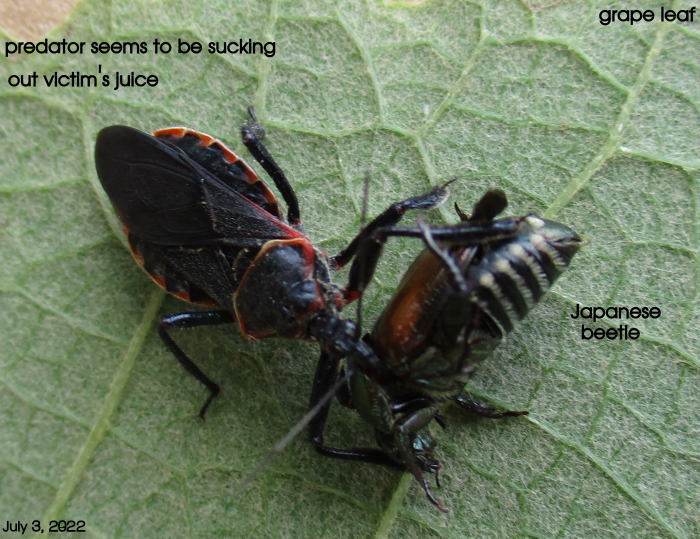 But not many. Their numbers diminish when kill them. Today I only noticed a few. One was being preyed on by an insect I don't recognize. A few leaves away sat a large assassin bug too, so I presume they eat these beetles.
But not many. Their numbers diminish when kill them. Today I only noticed a few. One was being preyed on by an insect I don't recognize. A few leaves away sat a large assassin bug too, so I presume they eat these beetles.
Weirder, yesterday I found a big HORNWORM the size of my little finger, on the underside of a grape leaf! I thought they only fed on solanacea. But doing a google search, I see they are a common vineyard pest. I had never noticed them on grapes before.
My camera refused to focus on these bugs until I broke off the leaf and laid it down. Luckily the bugs remained in place. And on that same leaf, just 5" away from the bugs, was a small hornworm.
Yet, no hornworms on my tomatoes at all, presumably because I sprayed them with strong cayenne powder. I took a mustard squeeze bottle from the dollar store. I had to cut the tip back a bit before it worked well. I avoid spraying near any flowers as it will repel pollinators.
Still tossing blossom end rotted tomatoes. I sprayed the plants down with chelated calcium in case it helps.
Getting plenty of cukes now. Getting some good-sized watermelons coming along.
The turmeric I had sprouted has been sitting in moist pots in the sun, but doing nothing. No further sprouting.
July 19, '22: Yes! A few days ago, I had my first cup of really minty tea in a long time. Tentatively, there is a possibility that rotted/shredded bark mulch might be a factor which helps mint flavor.
This morning I finally saw some life out of the turmeric I had planted: 2 of the 3 tubers suddenly stuck out an inch of sprout.
I have seen very few Japanese beetles since last post. The occasional stink bug and a few squash bugs. I took out the 2 squash plants that had not set fruit. Left the one that has a big fruit.
Plenty of hot dry weather lately. I have eaten a few watermelons and lots of cukes. The artichokes have not been growing, possibly due to the heat.
My tomatoes have doubled in height. I have been leaving the suckers on the new growth as it is no longer too dense. Tomatoes are still green, though. The blossom end rot stopped as soon as I sprayed them with chelated calcium.
Aug 4, '22: Last month ended with a drought-breaking 6" of rain (and it's raining again today). Surprisingly, none of my cantaloups cracked as a result, and only 1 tomato.
I did get 3 more end-rotted tomatoes after posting last, but then no more after I watered with a bit of epsom salt. Got my first little ripened tomato today.
The grapes that survived the mold finally turned a dark purple but did not taste great. Tasted a bit salty for some reason. Box turtles ate them though.
Now after the rains and slightly cooler weather, the cukes taste better. I ate a fair number of small cantaloups and a few watermelons. Some late-planted cantaloups are still on the vine. I harvested the few black beans I had grown, which produced small beans due to the heat I guess. We had been having a lot of 100-degree days.
The more moribund-looking artichoke sprouted new leaves after the rain, and the magic lilies sent up their flower sprouts belatedly, looking taller and more vigorous than usual. Starting to flower now.
Planted some bok choy seeds in starter trays.
Maybe the weather was too hot even for the turmeric? Considering the tubers are in black plastic pots and get a lot of sun. The 3rd one has finally sent up a short sprout. Another is about an inch tall, and one almost 3" and is beginning to unfold its first leaf. Note that each pot got a fairly substantial pre-sprouted tuber June 24.
Virtually no Japanese beetles lately. Some stink bugs and squash bugs. Not many grasshoppers even. Still no hornworms on my tomatoes; I put more cayenne on the plants after the rain. Oddly, I saw a huge one just crawling along the ground, far from any garden plants. Maybe it had been eating wild grape plants, dunno. I did not notice more on my grape vine but I was not looking hard either.
Aug 23, '22: The watermelons are all gone but one. I could have planted a few more seeds later than I did.
I still have a few cantaloups hanging on later-planted vines.
I still have more cukes than I can eat. After the heat broke, they lost their bitterness so that I can stand the juice.
I did not plant cukamelons this year, but they have been coming up in all sorts of places, and I was tearing them out so that they don't go to seed and hybridize with my lemon cukes. I used up all my lemon cuke seeds, so I have several big fruit hanging on for seed. Seeds don't form well until the fruit are pretty overripe.
This year I did not get very many tiny lemon cukes, despite the droughty heat wave. In fact I've been getting quite a few big ones, like baseball size. I grew fewer plants per container, plus pruned them often.
Now I am letting the cukamelons spread. They make a beautiful annual ground cover. If I end up with enough lemon cuke seeds this year, I can let the cukamelons grow more next year, and spread their fruit around more. Seems to me that wild box turtles might fancy them. It appears some birds do.
Of course they may not come up next year as so far they have not produced noticeable fruit, due to my interventions.
I ripped out some lemon cuke vines today that no longer had fruit. I COULD plant bok choy and lettuce starts in the same planters now, except that I waited too long to start new seedlings, and they are too small now. I planted some kale seeds in one of those today.
Still hardly any ripe tomatoes. The basil I had started from seed is producing well.
The only fig that seems productive is the Hardy Chicago. It had a bunch of fruit approaching ripeness, but some of those may have "disappeared", so yesterday I put bird netting over the bush.
The 2 artichoke plants have put out new growth, but no stems yet.
September 24: The artichokes still have put out no stems but have been growing some. I think they got stunted by the long heat wave after they were planted, before they got much in the way of roots estblished.
I finally found 2 fat hornworms on my tomato plant. At the top, which I had not sprayed cayenne on, figuring they would start at the bottom and work there way up. There was no damage lower on the plant but the top is skeletonized.
I discarded one of the 2 plants a while back because every single fruit on it had black blotches. The remaining plant does not have these, but every fruit that starts to get some color on it also develops bottom-end rot, despite my watering with epsom and chelated calcium.
Doubt I will ever grow tomatoes again.
It is odd that, despite all my orgone etc and improvements in soils and growing methods, I can no longer grow some things I used to be able to.
I gave up on tulsi a couple years ago. No matter how much I spent on pricey nitrogen-packed seed from different sources, none would grow. A couple years ago I planted Genovese basil and tulsi in the same way, in the same soil mix, in the same type of starter trays, and treated them the same. As usual, the tulsi only slowly grew about 3/4" tall and stayed there for a couple months, then died, whereas the Genovese did OK.
And if I can grow any turmeric at all, it comes out unusually bitter. The plants I have in pots now have finally been growing. The tip of the highest leaf is 16" up. But this is late September. Since they are in pots I can take them in if it gets cold. We'll see how they turn out...
I used to occasionally get a crop of fruit off of my Brown Turkey fig, but not a one in many years now. I have one plant left which I will demolish soon.
However, I actually did get a number of good fruit off my Chicago Hardy, and a few off my Celeste. At the rate the Chicago is going I may have oddles of fruit next year.
Cukes and melons are gone now. Cukamelon volunteers have black fruit on them.
I planted red and white daikon some weeks back, and the red is doing real well, despite some hot days. It has long necks around 1" diameter sticking up. Radishes are another crop I have had trouble growing in recent years, despite them bring the easiest crop to grow. Last year the diakon I planted only formed skinny little roots with no meat.
Some of the kale I planted is doing real well too.
Genovese basil is doing amazingly well. Not so much the overpriced starts I bought this spring, but the later ones I started from seed, which were transplanted into a planter and a raised bed at the end of heat wave. Unusually lush, tall, fast-growing plants with scant pest damage so far. They really seem to like the alfalfa-pellet enriched soil mix, afternoon shade, and less extreme heat.
Longevity leaf has been doing fine lately too, under the same conditions. It starts growing late in the season; not harvestable until August.
October 3, '22: I ripped out my last tomato plant in disgust Sep 24.
I ate my last fig and first daikon today. The red daikon I planted a couple months ago is growing much faster than the white. The one I picked was 2" in diameter and at least 3" sticking out above ground.
I have more whites coming up. Some of the kale is about ready to harvest. Been babying bok choi along. None of the lettuce seed I put in the ground has come up, or else it is getting eaten quickly. This is the time of year when grasshoppers abound, although they are not doing that much visible damage.
It has been pretty dry. I have only gotten maybe 2/10" since the end of August.
Oct 19, '22: We were officially in a severe drought. But I got 1.1" the night of the 14th, which helps a lot.
Then they were calling for 26F the night of the 17th and 23F the next night, so I harvested and froze my basil and longevity leaf. I transplanted 2 longevities into pots to take inside. I went to some trouble to protect my bok choy, daikon, artichokes, hardy romaine, and mint, but it only got down to 32 and 30 at my place. Hopefully enough to suppress the grasshoppers.
On the 16th I noticed saffron shoots starting to poke out in their pot. Artichokes STILL have not put out stalks. The potted turmeric has hardly grown at all this month, and the leaves are turning a bit. I brought them inside.
The lettuce seed I had planted outside -- only a couple little plants came up. But I transplanted some I had started in trays.
Jan 2023: Had a bunch of cold weather, some below 0 F in Decemember, which killed my bok choy and lettuce despite my covering them.
This coming season I plan to do a few things differently due to my increasing awareness of the importance of keeping oxalates low. Based on the oxalate-level information that seems most credible, I plan to- grow no beans except for black-eyed peas or limas
- grow spaghetti squash again
- Stop growing chard. Stop growing kale except for some Dino kale. I don't like it much due to its tastelessness, but kale is the only annual vegetable that can survive a normal winter here. Unless I build a serious insulated cold frame.
Unfortunately figs have oxalates too, which are pretty high in some varieties, and nobody knows which ones are lower.
June 3, '23: It has been a cool spring so far; warming up some lately.
Harvested my first garlic plant today, and the rest won't be long. Been having dry weather the past week which works out well for that.
Been eating lots of lettuce. Have planted more Winter Density Romaine which is supposed to tolerate the heat well. The purple Romaine from commercial starts does not like it so much and will burn out soon. This year I will see if I can keep some lettuce going all season by planting in shady spots.
I have also been getting lots of good mint the last few weeks.
A few blueberries are ripening. I transplanted the potted blueberry into a bed a few months ago and it likes that; set hundreds of fruit. My fruit trees did not flower.
I have Cantaloup, cukes, and watermelon plants up. Aside from Sugar Babies I am trying Golden Midget watermelons.
This year I will grow only Straight 8 in the way of cukes.
Yesterday I transplanted some basil I had started from seeds. Soon I will plant some squash seeds.
The potted saffron actually had not come up. That was some kind of grass or rush coming up I mistook for saffron sprouts. I gave up on that.
Likewise the turmeric never showed signs of life, but when i emptied out the pots i saw some tubers had start to sprout a bit. Nevertheless, I have stopped eating turmeric due to the oxalates so will not be growing it anymore.
Despite my attempts to protect them from cold, my artichoke plants disintegrated. But then, artichoke hearts are supposed to be high in oxalates so I will just renounce them too,
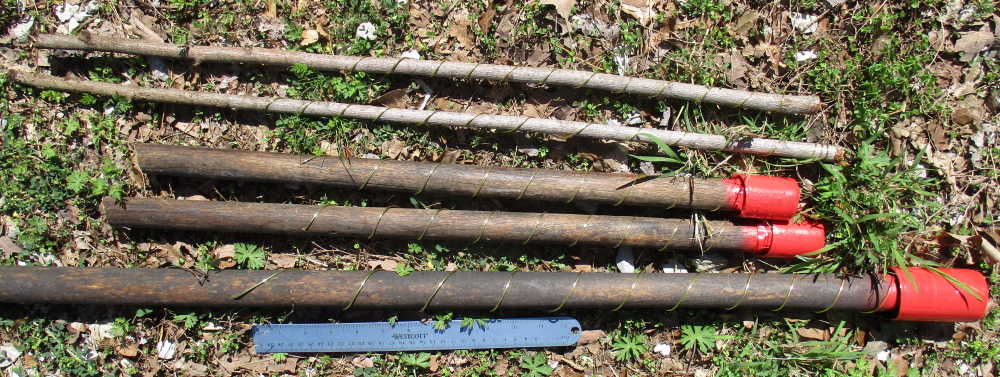 I've been making a bunch of electroculture wands of different lengths, some with bamboo, some wood, some fiberglass. And brass wire. I think these are effective. One container of mint was getting all mildewed, which reversed after I stuck in a wand, despite continued soggy weather.
I've been making a bunch of electroculture wands of different lengths, some with bamboo, some wood, some fiberglass. And brass wire. I think these are effective. One container of mint was getting all mildewed, which reversed after I stuck in a wand, despite continued soggy weather.
Frankly, all this orgone stuff has not resulted in any remarkable productivity, except in the case of the garlic. It was of value in dispelling the demons that used to be so common and which probably would have ruined things. But I suspect these wands will help a lot. Of course they are probably interacting with all the epoxy pieces, bionized stones and sand, etc.
The Gynura procumbens (longevity leaf) is a weird plant. Last spring I attributed the fact that they refused to grow to having grazed them down too much during the winter. So last winter I saved only 2 substantial plants, left them bushy, and took them outside anytime during the winter and spring when we had warm sunny weather. Nevertheless, they refused to put out any growth until this past week, and those leaves are too small to harvest yet. Last year they sprouted a few days earlier. The moral of the story is, don't bother to take them out in the sun early.
I saw a few chickadees in my garden yesterday, for the first time in over 3 years. Also I have seen a few cardinals this spring again.
July 5, '23: I had forgotten that one does not direct-sow greens in warm weather, as bugs will snarf the delicate sprouts before they get 1cm tall. So more recently I started some lettuce in indoor trays, which has largely sprouted. So now I have no lettuce to eat.
And it turned out that the Straight 8 cukes are horribly bitter and somewhat astringent. Maybe it is OK in cool environments, but not here. It has been relatively cool here, only getting into the low 90s about 5 times so far, with a max of 93F. So I ripped out all my beautiful cuke plants which i had been sucker-pruning daily, and planted lemon cuke seeds on July 4. Lemon cukes need hotter weather before they turn bitter, and even then, never turn as bitter as these Straight 8s did.
So I have nothing fresh to eat except basil.
The Gynura procumbens plants only started re-growing in late May, and now they still have not really grown much. I have eaten a few leaves but they are all oddly pale and they won't flatten out but remain curled inward oddly. Even though conditions must be pretty ideal for them. Reading this article, the only thing I can figure out is that perhaps I have been watering them too much. So I will let them dry out more. I did not have such a problem the last 2 years though.
Melon vines and basil are doing well. Squash coming along well. Not too many insect problems: just a few stink bugs on squash and melons, and tiny ants and aphids on the old grape vine. And some grasshoppers of course but not too many. I have seen 2 Japanese beetles so far.
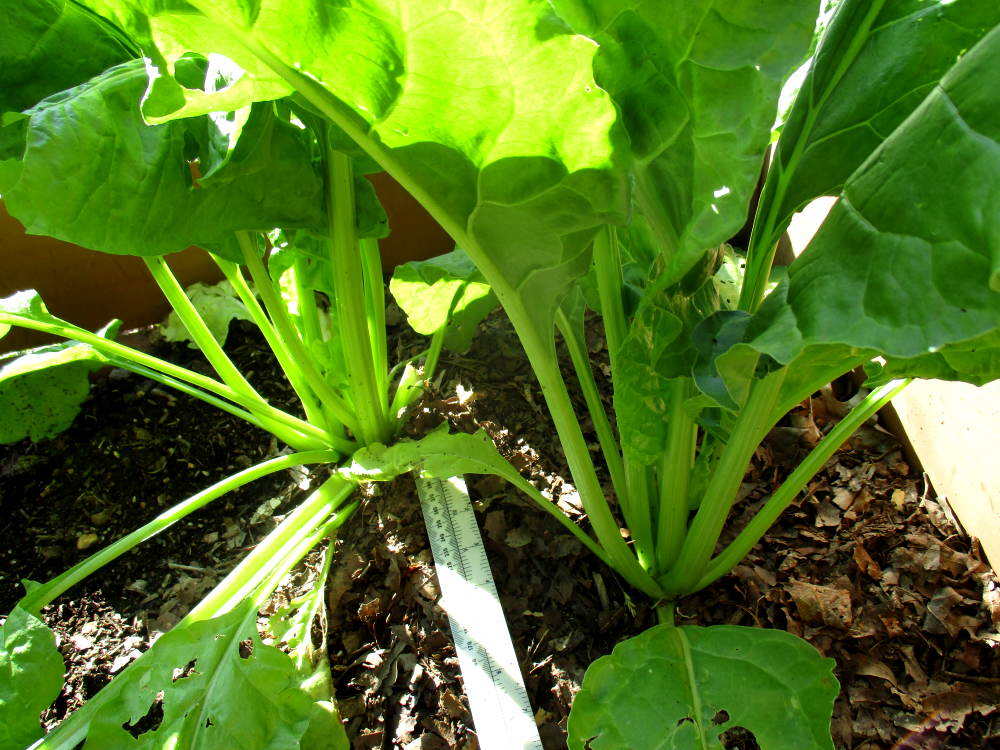 I have this mysterious plant in one bed. I had planted Density Romaine very early in that bed, which never came up, but much later these plants appeared which I assumed were the romaine at first, but then the leaves developed into something that resembles chard/beets/spinach. The leaves grew HUGE on long stalks, 20" overall, and produced prolifically. This pic was taken after large quantities had already been cut off near the base over time. Looks like chard but with narrower, greener stalks. I was eating some raw when I thought it was lettuce, but after that have been giving away copious amounts to a friend (with ample caveats) as this looks like these very high-oxalate plants.
I have this mysterious plant in one bed. I had planted Density Romaine very early in that bed, which never came up, but much later these plants appeared which I assumed were the romaine at first, but then the leaves developed into something that resembles chard/beets/spinach. The leaves grew HUGE on long stalks, 20" overall, and produced prolifically. This pic was taken after large quantities had already been cut off near the base over time. Looks like chard but with narrower, greener stalks. I was eating some raw when I thought it was lettuce, but after that have been giving away copious amounts to a friend (with ample caveats) as this looks like these very high-oxalate plants.
Another bizarre thing is that months later, when the lettuce season is long over, these plants are still producing some and have not bolted the slightest bit. I have no idea what they are as I never planted spinach or beets in that bed, and it was a couple years since I planted chard. And that chard did not have stems like these. And I did not have chard grow to seed.
I still have seen very few birds. Perhaps for that reason I was able to enjoy a few blueberries off the bush for weeks and there are still a very few left.
I did harvest and dry a large crop of garlic.
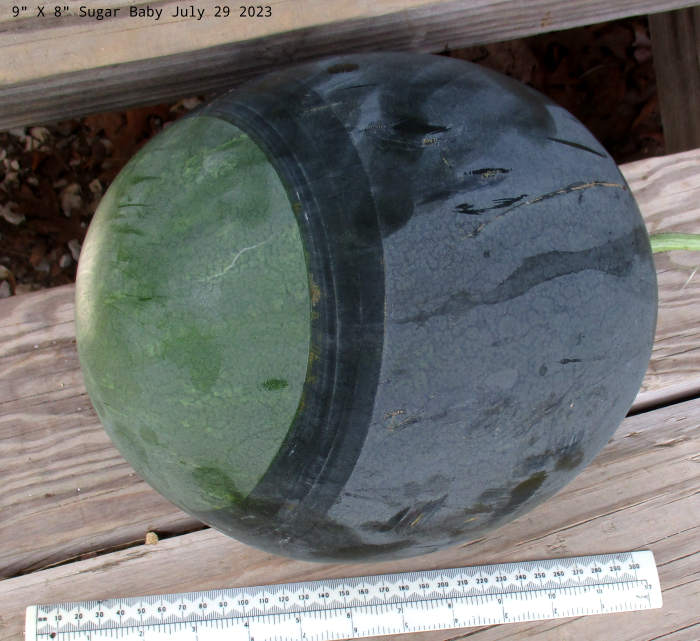 July 30, 2023: Been getting many cantaloups in recent days. Also yesterday I harvested this watermelon. Sugar Babies are officially supposed to get as big as this maximum, but this is several times the volume of those I have gotten in previous years. The lighter spot is where it was sitting up in a plastic pot to keep it off the ground.
July 30, 2023: Been getting many cantaloups in recent days. Also yesterday I harvested this watermelon. Sugar Babies are officially supposed to get as big as this maximum, but this is several times the volume of those I have gotten in previous years. The lighter spot is where it was sitting up in a plastic pot to keep it off the ground.
I am eating it as I type. Flavor is quite good; sweet but not as sugary as the name implies.
Watermelons are much more resource-intensive than cantaloups. It requires a great deal of foliage and water to make one fruit. A plant only makes 1 or 2 fruit. But, is life complete if one can't have a good watermelon once in a while?
This was grown in a 150-gallon planter with little competition. There are other watermelon plants in it but they were planted later and are still small.
The Gynura procumbens plants have finally taken off. Basil has been doing great. My late-planted lemon cuke vines are growing well. The mystery plant is still producing a bit despite the heat, and has not bolted. I have been eating yellow squash lately.
Scant problems with molds and mildew, despite it having been very humid and often wet until now. One lilac bush is covered by powdery mildew, but that is far from any of my electroculture stakes. I have only seen 2 Japanes beetles so far this year. My east garden has several squash plants but has had no squash bugs. My south garden did have some I got rid of, but I have not seen any signs of them in several days now. Haven't seen any stink bugs in a week or more. I did have ants and aphids on my larger grape vine weeks ago, but none since.
Hence I have to give some credence to this electroculture stuff. Some people make Ighina and Lakhovsy coils and various weird variations but so far I am only inclined to do the brass spirals on stakes.
But then again, I have been running some freqs against grasshoppers, squash bugs, stink bugs, and powdery mildew. But I've done nothing against Japanese beetles except kill a couple. And my lilac has mildew regardless.
Not sure that's done much to the grasshoppers but there are fewer large ones around. They were hitting me in the head for a while there. Grasshoppers are full of parasites that will eventually kill them if their life force weakens.
Aug 2, '23: Unfortunately, when I went outside the very next day, I found bunches of squash bug eggs and nymphs in the east garden, as well as in the south garden. And I have found more every day since. And today I ripped out my 2 spaghetti squash plants. They had only ever set 3 fruit between them, which turned soft and moribund before they grew much. Possibly because I let the plants dry out too much once, which stressed it out and killed off many leaves.
So, I have not found any magic bullets against squash bugs yet.
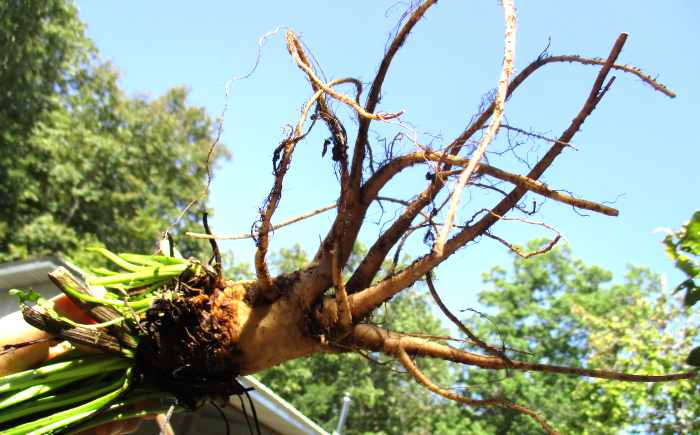 Sep 5, '23: The mystery greens still have not bolted. But they are all bug-eaten and have lost vigor and size. I ripped them up to plant some bok choy. Here is a root.
Sep 5, '23: The mystery greens still have not bolted. But they are all bug-eaten and have lost vigor and size. I ripped them up to plant some bok choy. Here is a root.
I have some Florida Broadleaf mustard growing nicely, and small kale plants up. Planted some of that romaine a couple days ago. Today planted some Bok choy and daikon.
Still getting a few occasional small cantaloups. Getting only a small amount of nice-tasting lemon cukes. The plants look great and are full of flowers but pollinators have gotten scarce. Nevertheless some yellow squash gets pollinated and those are still producing. I have not found any squash bugs or eggs in the last few days.
Gynura procumbens is picking up a bit but still not growing rampantly. I have a glut of basil and gave some away.
Still have only seen 2 Japanese beetles all year. Some grasshoppers about but they don't seem to be doing much harm. Hardly any stink bugs. Hardly any mildew problems except on a couple lilacs.
Oct 2, '23: The lemon cukes took off again and I have been getting lots. None of the lemon cukes have been bitter this year.
Ate the last cantaloup today. The last few took forever to ripen so I went without any for weeks.
Mustard has been growing very well and I've gotten some kale too. Gynura procumbens has been growing better. Still getting basil. Daikon and bok choy hardly doing anything yet. Still getting some squash.
Killed 2 stink bugs on my squash yesterday but aside from those 2 and the grasshoppers, no pests to speak of.
Even my apple is already in flower! Here is a pic, taken 4/15. The red balls are unopened flowers.
And my Brown Turkey fig is already about to leaf out. This is way early. Pic taken 4/12/5.
This pic taken 4/22/5. Note that the tips did not freeze back on the Brown Turkey fig. Some small, lower branches did. It is normal for most of the above-ground wood to die back (I planted only varieties that will fruit on new growth from the root). I have never had the tallest branches fail to freeze back at least halfway down from the top. As I said, I gave them no protection from the winter wind. I recorded 2 degrees F on 12/23/4 and 12/24/4, 3 degrees on 12/25/4, and 6 degrees on 1/23/5. It was a cold enough winter to kill most of my shrubby St. Johnswort perennials (which happens every few years).
Here's my other fig, already sprouting leaves.
Or, or... could it be that in the center I had a couple epoxy devices, one old one with a water bottle in it, that I retroactively programmed with nitrogen, etc. freqs, and a newer disk like I mentioned above? Well, I suspect the latter, so I made up some more of those disks, and put 4 more around the edges of the bed, at the cardinal directions (I'm into cardinal directions).
Here's a special "orgone carrot" I picked today.
Here's an oddity. I grew a different variety of russets this year, and a few of the plants formed berries. I did a web search, and found they are very poisonous.
Aug. 3, '07: On July 18 I found this tomato on one of my 2 Arkansas Traveler plants. I don't know what caused this. [Update: it is a very dark caterpillar that looks like a slug at a distance, I noticed years later.] But so far, no other blemishes or flaws of any magnitude on the fruit. No bugs in evidence, except for a few tiny holes in some of the leaves. I've been sprinkling a little agnihotra ash on them every few days. Ordinarily, I would have expected blister beetles and hornworms by now. Not to mention blossom-end-rot, which I have aways gotten some of before. I did find a few blister beetles on 7/20 on some beets in the lower garden that I had not ashed. Also on that day I picked my first 2 ripe tomatoes -- very late due to all the cool weather.
I grew a couple plants this year that are useful for orgone devices. One is holy basil AKA tulsi AKA tulasi. All parts of the plant have good energy. In the past I have used commercial Indian tulsi, a very fine powder, in orgonite mixes, sometimes quite liberally. Also I have some Indian carved beads made from tulsi stem.
Turmeric: Last Sep. 15 I blogged:
You can get fresh roots on eBay early in the year and plant them. However, based on years of experience i have found that it takes at least 5 weeks under ideal conditions for the shoots to pop up, then they grow very slowly for a month or 2 before getting of any size. Right now i have a few plants around a foot tall, and the rest are smaller, some still tiny even this late in the year. But summer arrived late this year.That was last year's crop. It was puny. My yield was about the same as my input of roots. Some of the plants did not even produce anything.Late Nov, 2015: I harvested turmeric on Nov 26.
It was a big hassle to clean. In warmer climates, people leave some plants in the ground over the winter to grow the following year. But I don't think I'll grow 2nd-year roots again. The differences I noticed:
And, after almost 14 months of colonization from spores, I found my first Wine Cap mushroom! In early March of last year I had planted in wood chips some spores I got from Fungi Ally. Supposedly this will now produce prolifically and spread wherever there are wood chips.
As I mentioned last July, searing winds had killed most of my garlic that winter. The garlic that survived, however, never put out scapes (seed spikes) which is unusual. I pulled them up when the leaves were dying and found that the bulbs had not visibly separated into cloves. They looked like small onions. These I kept and re-planted last November. I also planted some other garlic cloves. Many of the latter did not survive or thrive this winter either, despite having higher walls on the beds. However the big round bulbs from the previous winter grew into abnormally hefty plants. And today I pulled up a couple whose leaves were dying.
Last year I wrote:
I have been getting quite a few oversize lemon cukes... This despite a prolonged dry heat wave (cukes don't like it too hot). Was it the small amount of M-state stuff I sprinkled on where I planted the seeds? Or was it the layer of rich compost I put on top once the plants were established? Maybe the highly-aerated weed tea I irrigated with many times?So this year I did not add such things at first. I have been eating cucumbers a while now but have only gotten small ones. So a few days ago I put a bunch of rotted-leaf compost on the plants (but it was less rich and broken down than last year's). This did not seem to make a fast difference.But the ones with the large fruit have the more rounded leaves (left) whereas the vines with small fruit have the more angular, pointy leaves. (The leaves are not smaller in general.)
July 17, '19: I harvested the biggest of those cukes. Apparently they grow to a certain size (which varies) then stop and just hang in there tightly. It is difficult to break them loose from the vine even though ripe. Which is kind of good considering how heavy they are.
March 6, 2020: I guess all my chickadees died? It has been a milder than usual winter but I have not seen any in a while. I set up a trail cam by my feeder (with broken cashew pieces) and got several red (male) cardinals and this female Northern Cardinal. Well, cardinals are my friends, too, but I am sad not to see chickadees. Next winter I will start offering them food earlier.
Aug 26, '20: Not bad for my first attempt at growing sunflowers. I grew 3 "Giant Titan" plants, and the 2 biggest heads were about 14" in diameter. I just cut them to finish drying indoors. They feel super orgonized, presumably due to the growing environment.
September 18, 2020: Pressure on the beans gets strong this late in the year. Now I have tiny gnats or something plus a bunch of these little guys eating the beans. Nymphs of green stinkbugs.
October 18, 2020: I have torn out almost all my bean vines and most of my cantaloup vines.
Yum. I eat a lot of cooked greens in the cool part of the year, and I really like these.
None of these 3 newish autumn olives has fruited yet, except the one red which produced 3-4 dozen golden berries. The mother tree and its mother have only ever produced red fruit.
But not many. Their numbers diminish when kill them. Today I only noticed a few. One was being preyed on by an insect I don't recognize. A few leaves away sat a large assassin bug too, so I presume they eat these beetles.
I've been making a bunch of electroculture wands of different lengths, some with bamboo, some wood, some fiberglass. And brass wire. I think these are effective. One container of mint was getting all mildewed, which reversed after I stuck in a wand, despite continued soggy weather.
I have this mysterious plant in one bed. I had planted Density Romaine very early in that bed, which never came up, but much later these plants appeared which I assumed were the romaine at first, but then the leaves developed into something that resembles chard/beets/spinach. The leaves grew HUGE on long stalks, 20" overall, and produced prolifically. This pic was taken after large quantities had already been cut off near the base over time. Looks like chard but with narrower, greener stalks. I was eating some raw when I thought it was lettuce, but after that have been giving away copious amounts to a friend (with ample caveats) as this looks like these very high-oxalate plants.
July 30, 2023: Been getting many cantaloups in recent days. Also yesterday I harvested this watermelon. Sugar Babies are officially supposed to get as big as this maximum, but this is several times the volume of those I have gotten in previous years. The lighter spot is where it was sitting up in a plastic pot to keep it off the ground.
Sep 5, '23: The mystery greens still have not bolted. But they are all bug-eaten and have lost vigor and size. I ripped them up to plant some bok choy. Here is a root.
 home coil info products ordering
home coil info products ordering





